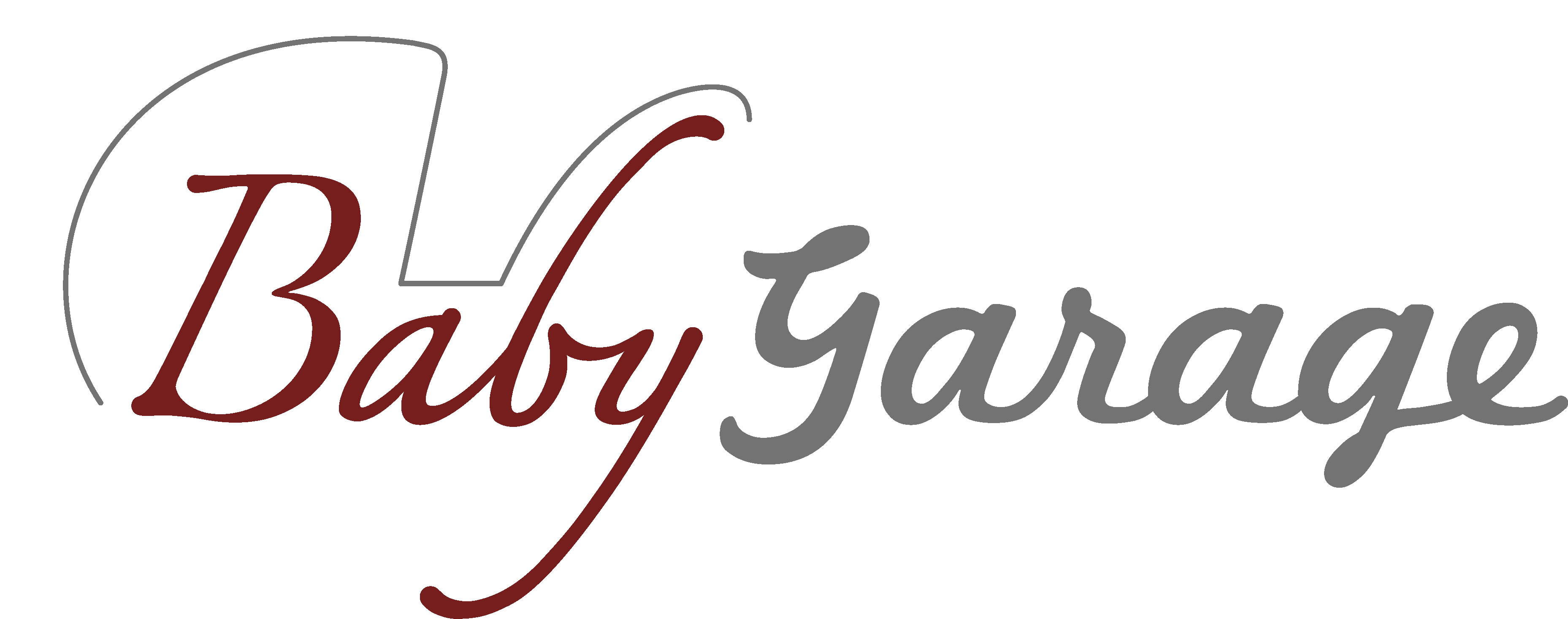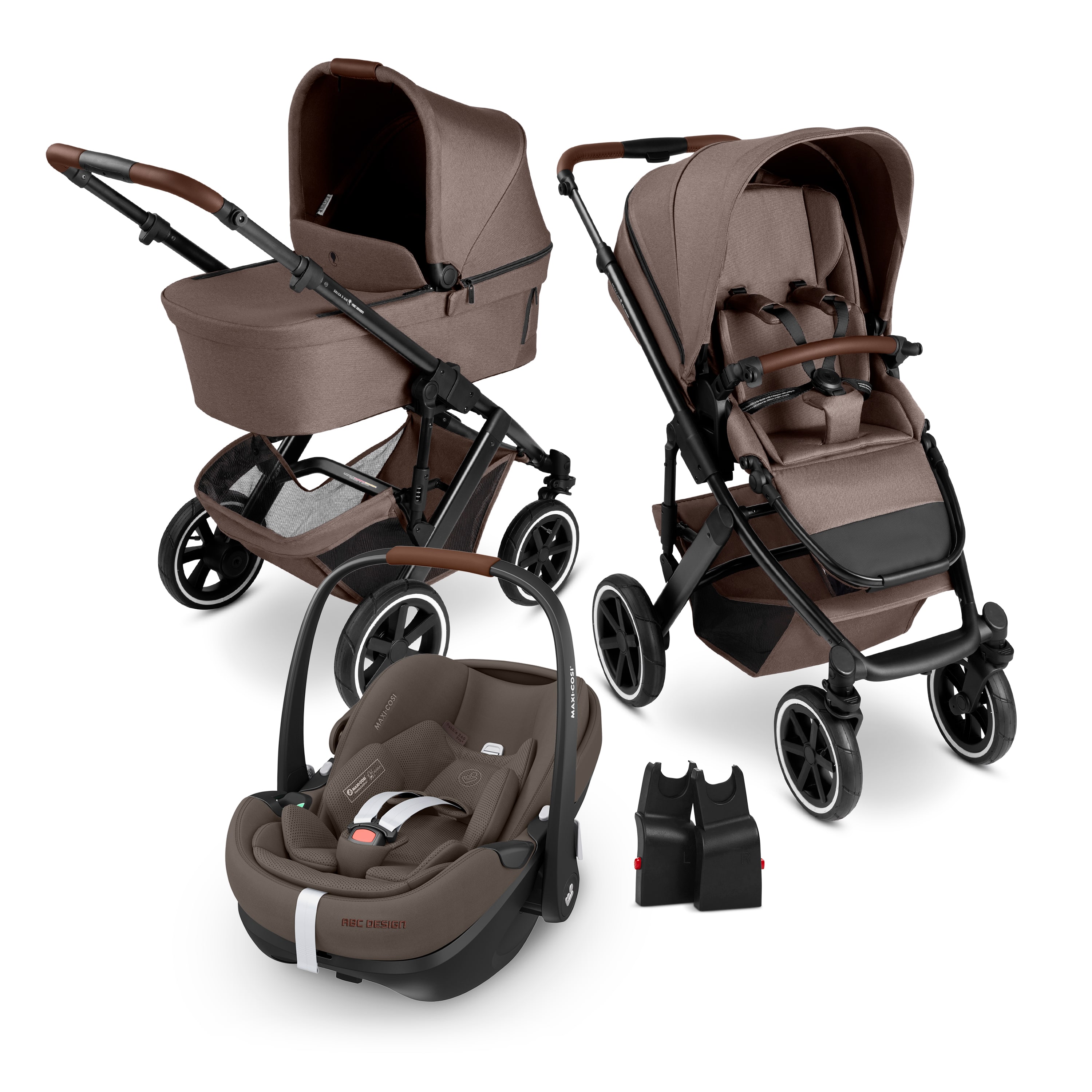
Get your family adventure off to a relaxed start with the ABC Design Salsa 5 Air set, combined with the innovative Maxi-Cosi Pebble 360 Pro 2 infant car seat and matching adapters. This premium set offers the perfect symbiosis of comfort, safety and design for your baby from birth to toddlerhood. Experience seamless transitions from car to pushchair and enjoy maximum flexibility on all your journeys - whether in the city or in the country.Features ABC Design Salsa 5 Air pushchair:Age suitability: From birth to approx. 4 years of ageMaximum weight of child: 22 kgShopping basket load: 5 kgFrame: 10.1 kgSeat unit: 4.8 kgAccessories: 0.2 kgUnfolded: 95.5 x 63.0 x 118.0 cm (LxWxH)Folded dimensions: 86.0 x 63.0 x 42.0 cm (LxWxH)Folding dimensions without wheels: 71.5 x 55.0 x 24.5 cm (LxWxH)Seat: 21.0 x 30.0 cm (LxW)Backrest: 52.0 x 30.0 cm (HxW)Footrest: 25.0 x 30.0 cm (LxW)Lying surface seat: 98.0 x 30.0 cm (LxW)Type of push bar: Telescopic push barPush height: 98.0 - 107.5 cmFolding system: Two-hand foldingType of tyres: Pneumatic wheelWheel size: Front wheel: 24.5 cm / rear wheel: 27.5 cmSuspension: Single wheel suspension with additional suspension on the rear axleParking brake: Foot-operatedSelectable viewing direction: Yes - convertible seat unitBackrest: 4-way adjustable (up to lying position)Features ABC Design car seat adapter:Pushchair compatibility: Salsa 4 Air, Salsa 5 Air, Salsa Run, Salsa 5 Run, Samba, Samba 2, Zoom, Zoom 2, Ping 2 (only in combination with Ping 2 Connector)Compatibility infant car seats: ABC Design: Tulip, Cybex: Aton, Aton 5, Aton M, Aton M i-size, Aton Q, Aton Q Plus, Aton Q i-size, Cloud Q, Cloud Q Plus, Cloud Z i-size, Cloud Z2 i-size, Cloud T, Maxi-Cosi: City, Cabrio-Fix, Coral, Pebble, Pebble Plus, Pebble Pro, Pebble 360, Joie: i-Gemm, BeSafe: iZi Go Modular X1 i-Size, Go Beyond Avionaut: Cosmo, Pixel, ProCompatibility old models: Salsa 4, Vicon 4, Turbo 4, Turbo 6, Condor 4, Condor 4 Air, Tereno 4, Tereno Air, Viper 4, Catania 4, Merano 4(only for pushchairs with a production date from 2017)Features Maxi Cosi Pebble 360 Pro2:Age: from birth to approx. 18 months (40 to 87 cm)Maximum weight of the child: up to 13 kgDimensions: 66 cm x 44 cm x 58 cmWeight: 4.7 kgGroup 0+ child car seatthree recline/seat positions incl. flat recline functionrearward-facing modeG-CELL side impact technologyClimaFlow temperature regulationFlexiSpin 360° rotation system on the Joolz x Maxi-Cosi FamilyFix 360 Pro base station (sold separately)Fastening in the vehicle: 3-point vehicle belt or ISOfix stationapproved by the new ECE R129/03 i-Size approval standardapproved for aircraft usesustainable EcoCare fabrics (made from recycled plastic bottles)Care instructions: removable cover can be cleaned in the washing machine at 30 °CCompatible with: Joolz x Maxi-Cosi FamilyFix 360 Pro base station, Joolz Geo3, Joolz Day5, Joolz Aer+, Joolz Hub+Scope of deliverySalsa 5 Air frame incl. pneumatic wheels, foldable carrycot incl. protective cover, soft CozyCloud® mattress, carrycot organiser, seat unit (incl. cover fabric), comfort seat cushion Comfort seat pad, HappyBelt® 5-point harness system with magnetic fastener, shopping basket, play and safety bar with 2 attachment points for accessories, sun canopy (UPF50+), ABC Design car seat adapter for Samba, Salsa and Zoom, Joolz x Maxi Cosi Pebble 360 Pro 2 infant car seat, newborn insert, sun canopy
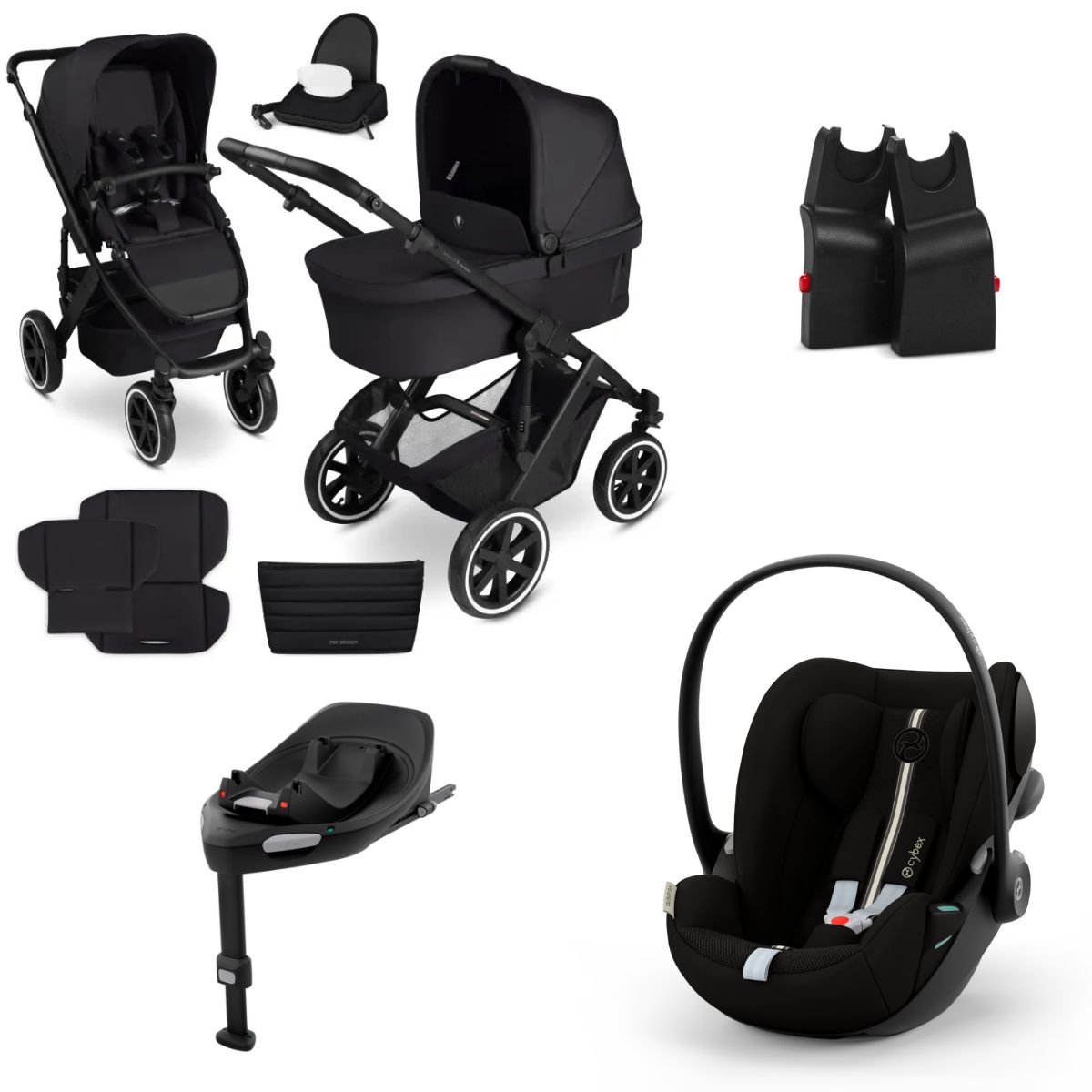
The ABC Design Salsa 5 Air set combines three first-class products to offer you and your baby the ultimate in comfort and safety. The ABC Design Salsa 5 Air pushchair impresses with its large pneumatic wheels and sophisticated suspension, which glide smoothly over various surfaces and make every walk a pleasure. Thanks to the new folding system, the carrycot can be stowed away quickly and easily, and the canopy can be adjusted effortlessly with one hand. The Cybex Cloud G infant car seat provides the best protection and comfort with its ergonomic recline position, improved side impact protection and a flexible headrest that grows with the child up to 87 cm tall. The set is completed by the Cybex Base G, which enables stable and secure attachment of the infant car seat in the car with its ISOFIX system. Together, these products offer a well thought-out and flexible solution for all your trips and journeys with your baby.Features ABC Design Salsa 5 Air:Age suitability: From birth to approx. 4 years of ageMaximum weight of child: 22 kgShopping basket load: 5 kgFrame: 10.1 kgSeat unit: 4.8 kgAccessories: 0.2 kgUnfolded: 95.5 x 63.0 x 118.0 cm (LxWxH)Folded dimensions: 86.0 x 63.0 x 42.0 cm (LxWxH)Folding dimensions without wheels: 71.5 x 55.0 x 24.5 cm (LxWxH)Seat: 21.0 x 30.0 cm (LxW)Backrest: 52.0 x 30.0 cm (HxW)Footrest: 25.0 x 30.0 cm (LxW)Lying surface seat: 98.0 x 30.0 cm (LxW)Type of push bar: Telescopic push barPush height: 98.0 - 107.5 cmFolding system: Two-hand foldingType of tyres: Pneumatic wheelWheel size: Front wheel: 24.5 cm / rear wheel: 27.5 cmSuspension: Single wheel suspension with additional suspension on the rear axleParking brake: Foot-operatedSelectable viewing direction: Yes - convertible seat unitBackrest: 4-way adjustable (up to lying position)Cybex Cloud G features:Age: from birth to approx. 24 months, 40-87cmMaximum weight of the child: 13kgWeight: 3.9kgDimensions: 68 - 72 cm x 43.5 cm x 35.5 - 59.5 cm14 different headrest positionsNewborn insert180° rotation with Base GReclining positionAdjustable XXL sun canopy with UPF 50+ protectionFabric covers machine washable on delicate cycleCompatibility: with Sensorsafe, Base G, with corresponding adapter with Cybex pushchairs and buggies and pushchairs from other brandsBase G features:Age with infant car seat: from birth to approx. 24 monthsAge with child seat: from 24 months to approx. 4 yearsISOFIX arms for quick installationRotation: 360° with child seat, 180° with infant car seatCompatible with: Cybex Cloud G i-Size, Cybex Sirona G i-SizeScope of delivery: Salsa 5 Air frame incl. air wheels, foldable carrycot incl. protective cover, soft CozyCloud® mattress, carrycot organiser, seat unit (incl. cover fabric), comfort seat pad, HappyBelt® 5-point harness system with magnetic fastener, shopping basket, play and protection bar with 2 attachment points for accessories, sun canopy (UPF50+), Cloud G, newborn insert, Base G

Riding backwards or forwards at some point? The Beyond 360 Reboarder offers pioneering new functions that allow children up to the age of around 6 years to ride in a rear-facing mode only or even a little earlier in a forward-facing mode. At the same time, it offers all the comfort that we no longer want or need to do without. Safety is always the top priority for BeSafe when designing the reboarder. The side impact protection (SIP+) and the force-absorbing material of the headrest with Dynamic Force Absorber™ provide additional protection in the event of side collisions. The material of the reboarder has not only been further developed with regard to increased safety, but is also characterised by its robustness, durability and lightness. Dhe low weight is clearly noticeable in everyday life, shen the seat needs to be moved between cars. Thanks to the Isofix station, changing the seat is super quick and easy. The advantages of the Beyond 360 are also evident in other features. Even children of around 6 years of age can be placed in a resting position in it to take a relaxed nap. Thanks to the 16 cm extendable bumper bar of the Beyond base, your child can enjoy optimum comfort and freedom of movement up to a height of around 125 cm and 22 kg, so you don't have to worry prematurely about whether they can still ride backwards. The spirit level integrated in the base ensures that the seat is always correctly and comfortably inclined. One-handed rotation on the base makes it easy for parents to get in and out of the car seat quickly and without straining their backs. The headrest can also be adjusted in 11 positions up to a height of 125 cm. The practical magnetic belt assistants hold the seat belts at the side and make it easy to buckle your child in without having to rummage around behind their little back. This makes everyday car journeys child's play! Typical for BeSafe, the Beyond 360 boasts unrivalled safety and is a real innovation! As part of the Beyond modular system with a service life of 15 years, you are investing in long-term safety and flexibility and are perfectly equipped right from the start. Ride backwards up to 6 years and stay flexible! Reversing is 5x safer for children! A child's head is disproportionately large and heavy in relation to the rest of its body. As a result, the head and neck area is more susceptible to (serious) injuries in the event of a collision. To provide children with the best possible protection, they should be rear-facing for as long as possible. The BeSafe Beyond system allows a personalised and flexible choice and adapts completely to the needs of families. The child seat can be used from a height of 61cm (approx. 6 months) or for changing after the infant car seat. For small children in particular, the resting position offered by the seat is a pleasant solution for short or long naps on longer car journeys. The head is prevented from falling forwards during sleep and the body can relax and recharge its batteries in the seat. If you have to carry your sleeping child out of the car on arrival, the swivel function of the seat on the base helps to gently and carefully transport the little ones out of the car. These functions are also an advantage for older children. If there is a long journey ahead, (pre-school) children are sometimes still very small and need a break. Comfortable reclining and plenty of legroom by changing the angle of the impact plate on the Isofis base ensure that even older children up to a height of 125 cm and 22 kg can still enjoy all the benefits and above all the safety of using a reboarder. Dimensions and other features: Age: approx. 6 months to 6 years Weight: 5kg Height: rear-facing: 61 cm to 125 cm Height: Forward-facing: 88 cm to 125 cm Weight of the child: 22kg 360 degree rotation rearward facing up to 87cm with locking function Headrest positions: 6 Legroom positions: 3 Installation: ISOFIX with base Five-point harness system Additional protective headrest with Dynamic Force Absorber™ Additional side impact protection (SIP+) Extended legroom up to 16 cm Reclining position magnetic belt assistants 11-stage adjustable headrest that grows with the child recyclable material Scope of delivery: BeSafe Beyond 360 Reboarder (BeSafe Beyond Base sold separately)
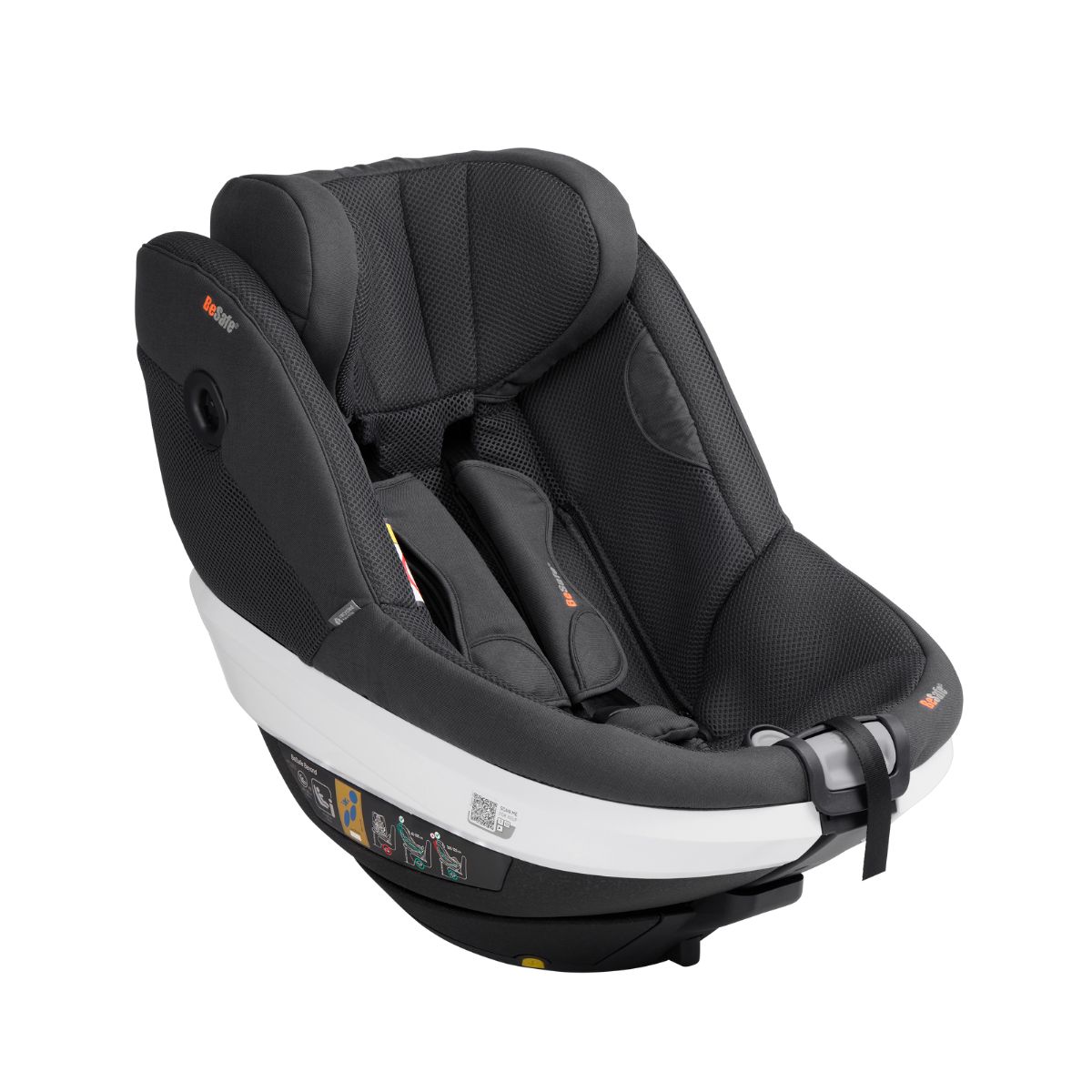
The BeSafe Beyond Reboarder presents a ground-breaking new feature that allows children up to the age of around 6 to travel in the car in a rear-facing mode only, which is five times safer! At the same time, it offers all the comfort that we no longer want or need to do without. Safety is always the top priority for BeSafe when designing the reboarder. In the event of side collisions, the side impact protection (SIP+) and the force-absorbing material of the headrest with Dynamic Force Absorber™ provide additional protection. The material of the reboard has not only been further developed with regard to increased safety, but is also characterised by its robustness, durability and lightness. Dhe low weight is clearly noticeable in everyday life, shen moving the seat between cars. The advantages of the Beyond 360 are also evident in other features. In hardly any other child seat can 6-year-old children, for example, be placed in a resting position that ensures they can sleep comfortably on long journeys. Thanks to the 16 cm extendable impact plate of the Beyond base, your child can enjoy optimum comfort and freedom of movement up to a height of around 125 cm and 22 kg. The spirit level integrated into the base ensures that the seat is always correctly inclined to suit your little one. Getting in and out of the seat is made easier by the sideways rotation on the base, which is an enormous relief, especially as your child gets older and weighs more. The headrest can also be adjusted in 11 positions up to a height of 125 cm. The practical magnetic belt assistants hold the seat belts at the side and ensure that your child can be buckled in effortlessly - you will appreciate it. Everyday life made easy! With its unrivalled safety, the Beyond reboarder is a real innovation! As part of the Beyond modular system with a service life of 15 years, you are making a long-term investment in safety and flexibility. Reverse travel up to 6 years! A child's head is disproportionately large and heavy in relation to the rest of its body. Accordingly, the head and neck area is more susceptible to (serious) injuries in the event of an accident. In order to protect children as well as possible while travelling by car, they should ride backwards for as long as possible, as this increases safety fivefold. This child seat can be used from a height of 61cm (approx. 6 months). The Beyond system adapts to the needs of the child. The resting position offered by the seat is a pleasant solution for small or larger naps on longer car journeys, especially for toddlers, but slightly older children will also appreciate the comfort of the reclining position and the deep headrest, which prevents the head from falling down. Cosy reclining and plenty of legroom by changing the angle of the rebound plate on the Isofis base ensure that even older children up to a height of 125 cm and 22 kg can still enjoy all the benefits and above all the safety of using a reboarder. If you have to carry your child out of the car asleep on arrival, the swivelling option of the seat on the base helps to gently and carefully transport the little ones out of the car. These functions are also an advantage for older children. Dimensions and other features: Age: approx. 6 months to 6 years Weight: 5kg Height: 61 cm to 125 cm Weight of the child: 22kg Sideways rotation rearward facing with locking function Headrest positions: 6 Legroom positions: 3 Installation: ISOFIX with base Five-point harness system Additional protective headrest with Dynamic Force Absorber™ Additional side impact protection (SIP+) Extended legroom up to 16 cm Reclining position magnetic belt assistants 11-stage adjustable headrest that grows with the child recyclable material PLUS Test approved Scope of delivery: BeSafe Beyond Reboarder (BeSafe Beyond Base sold separately)
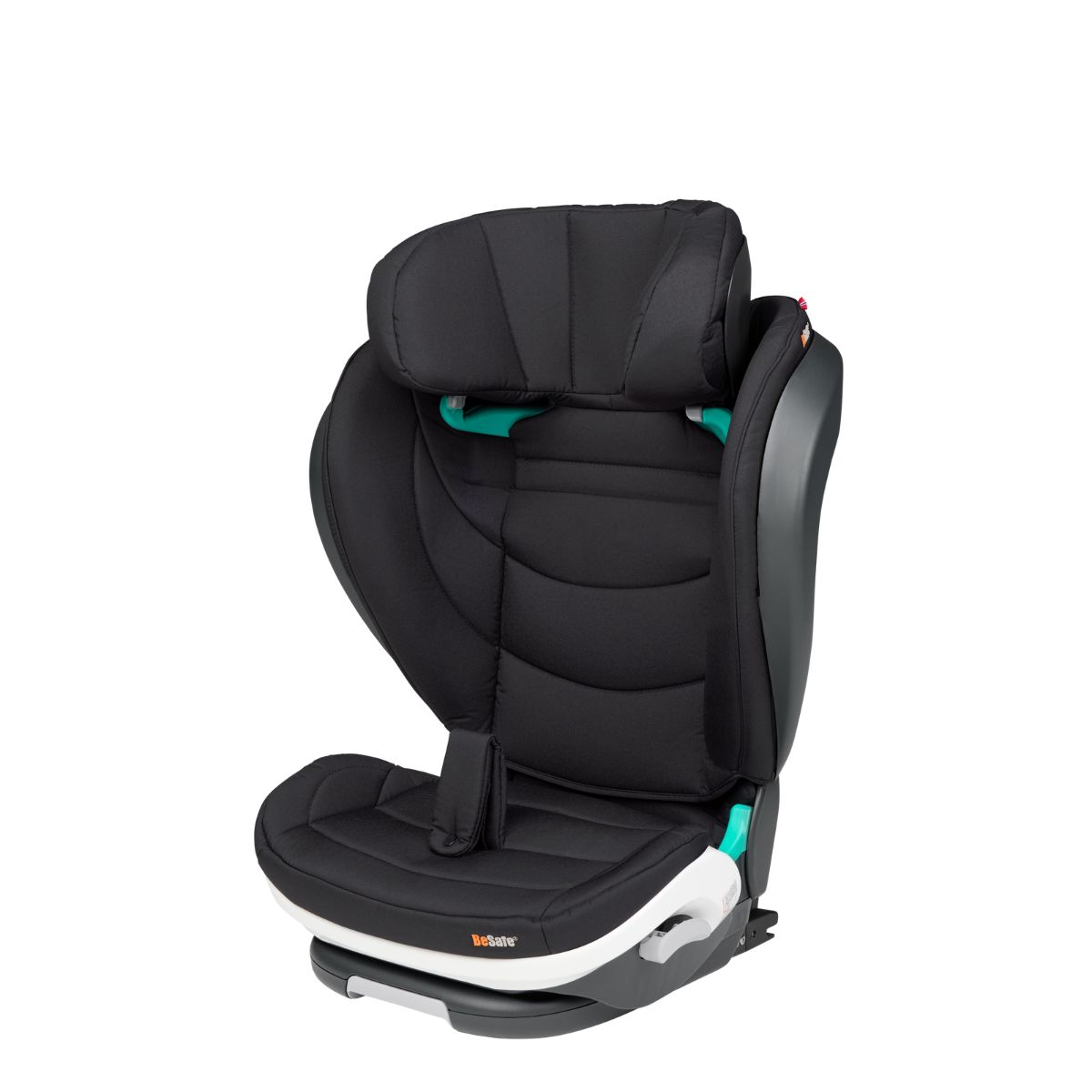
The BeSafe Flex Fix 2 - Only the best and above all the safest for your child. The BeSafe Flex Fix 2 impresses with its innovative Dynamic Force Absorber. This is innovative because it is made of a new material: EEP (expanded polypropylene). EEP is particularly hard-wearing and can dissipate forces very well in the event of an accident. It is also a lightweight material and its air permeability ensures optimum ventilation at the back of the head. The Flex Fix 2 is a perfect car seat that will accompany your family safely for many years to come. It has been designed to ensure that your child is not only protected by numerous safety features, but will also feel really comfortable in it. The V-shaped headrest is very comfortable and offers a great field of vision. The resting position can be adopted without any increased risk to safety. The seat also has no armrests to minimise the risk of operating errors, giving your child additional flexibility and freedom of movement. This allows your child to relax during the car journey from the many adventures or enjoy the view, while you can sit back and relax, knowing that your child is safely protected. All cover fabrics can be removed and machine washed. Features: Dimensions: 42 cm x 52 cm x 64 cm (in lowest headrest height adjustment and with SIP bumpers) Height of the child: 100-150 cm (i-Size booster seat for body height 100 - 135 cm Vehicle-specific booster seat for a height of 135 - 150 cm) Age: Approx. 4 - 12 years Weight: 7kg Installation: 3-point vehicle belt or ISOfix with 3-point vehicle belt Orientation: Forward facing Approved: i-Size UN R129-02 Scope of delivery: BeSafe Flex Fix 2 child car seat, shoulder pads, side impact protection

The new BeSafe Go Beyond infant car seat is the first component of the Beyond modular system! With the Go Beyond, you can put your little one in a reclining position and secure it with a 5-point harness. In the event of a collision, the infant car seat moves from the reclining to the sitting position. An absolute novelty! It is suitable for babies from a height of 40 cm and up to 87 cm. There is an optional insert for particularly small babies and premature babies, which is designed to ensure a particularly good fit for the little one. Everything is perfectly thought out! Another real game changer is the carry handle, which can be adjusted with just one hand, making everyday use easier. The Go Beyond also impresses with features such as the Peekaboo sun canopy, which can be flexibly bent in the direction of the sun's rays or pulled far down. The 10-stage adjustable headrest, which can be easily adjusted with just one hand, makes it easy to adapt the seat perfectly to the child's size. The materials of the Go Beyond not only offer improved protection in the event of side collisions (SIP+), but have also been specially developed to be robust, durable and lightweight. In combination with the Beyond Base, the infant car seat allows easy rotation towards the car door to lift your baby in and out effortlessly. A particularly practical feature is that the Go Beyond can be secured using both the Isofix station and the car seat belt. This makes it easy to switch between different cars at any time. The BeSafe Go Beyond is the most modern, safest and most flexible solution for your child and a true innovation. Practical in everyday life The reclining position of the Go Beyond is an advantage in many situations. Firstly, it is the safest and most gentle solution for babies when travelling, and thanks to its very flat reclining position, the infant car seat can also be used on the pushchair frame for a limited time without feeling guilty. It is not uncommon for babies to fall asleep while you are still doing something. Thanks to the Go Beyond, it is not absolutely necessary to move them into the pushchair. The little ones lie in a comfortable and healthy back position and can continue to sleep while the infant car seat is attached to the pushchair frame with a click. The easy removal of the infant car seat is particularly practical, as the fastening sides can be pulled apart with light pressure and easily detached from the frame. No more awkward jolting that could wake your little one. The Peekaboo sun canopy, which can be flexibly adjusted depending on the amount of sunlight, prevents the sun from shining in your little one's face and ensures a darkened environment. Optional accessories such as a summer cover round off the range perfectly. Dimensions and other features:Age: 0 to 18 monthsHeight: 40 cm to 87 cmWeight of the child: 13kg max.Maximum weight of the infant car seat: 5 kgSideways rotationrearward facingInstallation: ISOFIX with base or with the car seat beltFive-point harness systemAircraft approvalPeekaboo sun canopy with one-sided optionCompatible with several pushchair modelsReclining function when installed with Beyond Basecan also be harnessed in the recline positionActive lay flat™ function - automatically adjusts to an upright position in the event of a collisionScope of delivery: BeSafe Beyond Go infant car seat (BeSafe Beyond Base sold separately)

BeSafe iZi Go Modular X2 i-Size Safety comes first! Your newborn is optimally protected by the innovative headrest, which absorbs a possible crash, like a trampoline. This is ensured by special, flexible materials and a unique design with different flex zones. Further safety is provided by the additional side impact protection and the 5-point harness. With the BeSafe iZi Go Modular X2 i-Size, everyday life is easy. For a smooth process, the shell can be attached easily and effortlessly with a click on the ISOfix base station. Easy handling is ensured by the lightweight and ergonomically shaped carrying handle. And once your child has grown, you can attach a child seat from the iZi Modular concept to the same ISOfix base station. In addition, the magnetic seat belt assistant helps with buckling up. Sufficient protection from the sun is provided by the flexible and deep-reaching sun canopy with UPF 50+ protection, which can be used independently of the carrying handle. Highlights Optimal protection SAFETY is our top priority! In the event of an accident, the innovative headrest, made of special materials and various flex zones, offers optimum protection. The headrest is particularly narrow at the back and opens towards the front. So your newborn, as well as your growing child, is protected. 10x flatter resting position In this infant carrier, your newborn lies 10x flatter, minimizing the risk of the head falling forward. In addition, the supporting materials in the side area provide stability, safety and comfort. Effortless on the road! The extra light weight and uncomplicated installation make everyday travel simple and effortless. The magnetic belt assistant also makes it easier to get in and out of the seat. Technical data and features Weight: approx. 4.2 kg Dimensions: 66 cm x 44 cm x 59 cm (with the carrying handle in the carrying position) Driving direction: Reverse Covers: Machine washable Usage: from birth to 12 months/ 40-75 cm Compatible with: BeSafe iZi Modular Base Scope of delivery: BeSafe iZi Go Modular X2 i-Size Installation: ISOfix with separately available base station
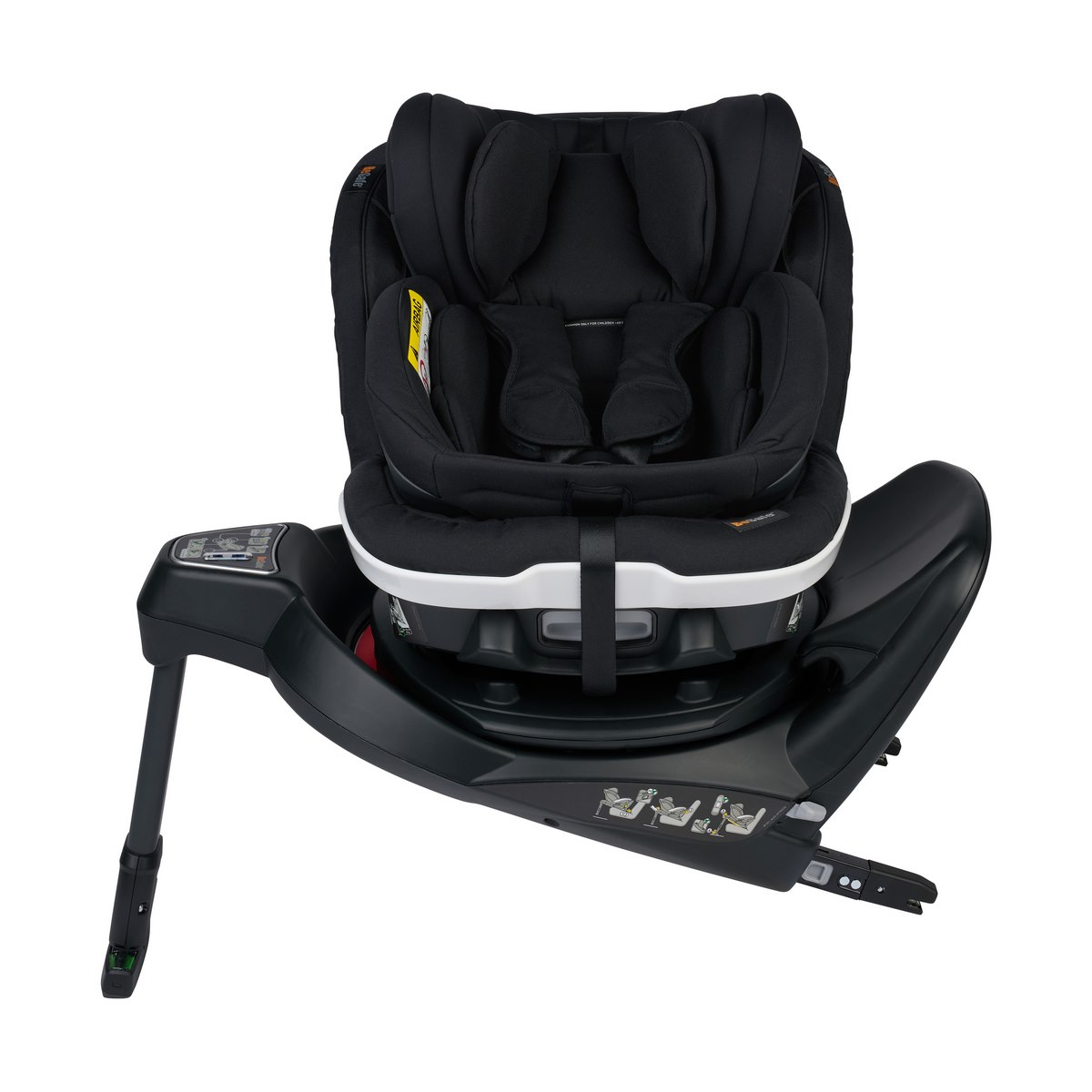
Are you looking for a child car seat that will accompany your child from birth up to the age of 4? You don't want to miss out on the convenience of being able to swivel the seat on the base? And do you want your child to be able to enjoy travelling in a rear-facing mode at some point? Then the BeSafe iZi Turn B i-Size Reboarder is the right seat for you. The iZi Turn is a reboarder that is firmly attached to its base and has the convenience of being rotated 360° on the base. The Turn can therefore be used facing in the opposite direction and from a minimum age of 15 months also in the direction of travel. The practical swivel function also makes it easier to lift your child in and out of the car. However, the spacious legroom gives you as parents the option of having your child ride rear-facing for as long as possible. Safety is a top priority Approved according to i-Size standards, the iZi Turn reboarder fulfils the highest safety requirements. The Isofix safety system makes installation in the car user-friendly and prevents errors. The visual and acoustic indicators also contribute to this. They recognise whether the seat is optimally installed in the car and point out any errors. Thanks to the latest technologies, the base can be installed in such a way that your child can sit at the optimum angle. The iZi Turn reboarder can be used from birth up to a height of 105 cm. Your baby is snuggled in the seat from day one with the Newborn Hugger™. This is removed as the baby grows. The Baby Shell™ continues to reduce the size of the seat and adapts perfectly to the child's body. This can also be removed as required. Your child is secured in the seat with the 5-point harness. The SIP+ is also attached to the seat for protection in the event of a side impact. Features: 360° swivel function integrated Isofix base station headrest and shoulder straps grow with your child in 10 stages Magnetic Belt Assistants™ visual and acoustic indicators on the base Baby Hugger™ 4 adjustable recline positions Approved according to: UN R129 (i-Size) Height of the child: rearward facing 40 - 105 cm, forward facing 88-105 cm Weight: 18 kg Age: approx. 0 months - 4 years Direction of travel: rear-facing or forward-facing Installation: ISOfixScope of delivery: BeSafe iZi Twist B i-Size with integrated base, Newborn Hugger™, Baby Shell ™, SIP+
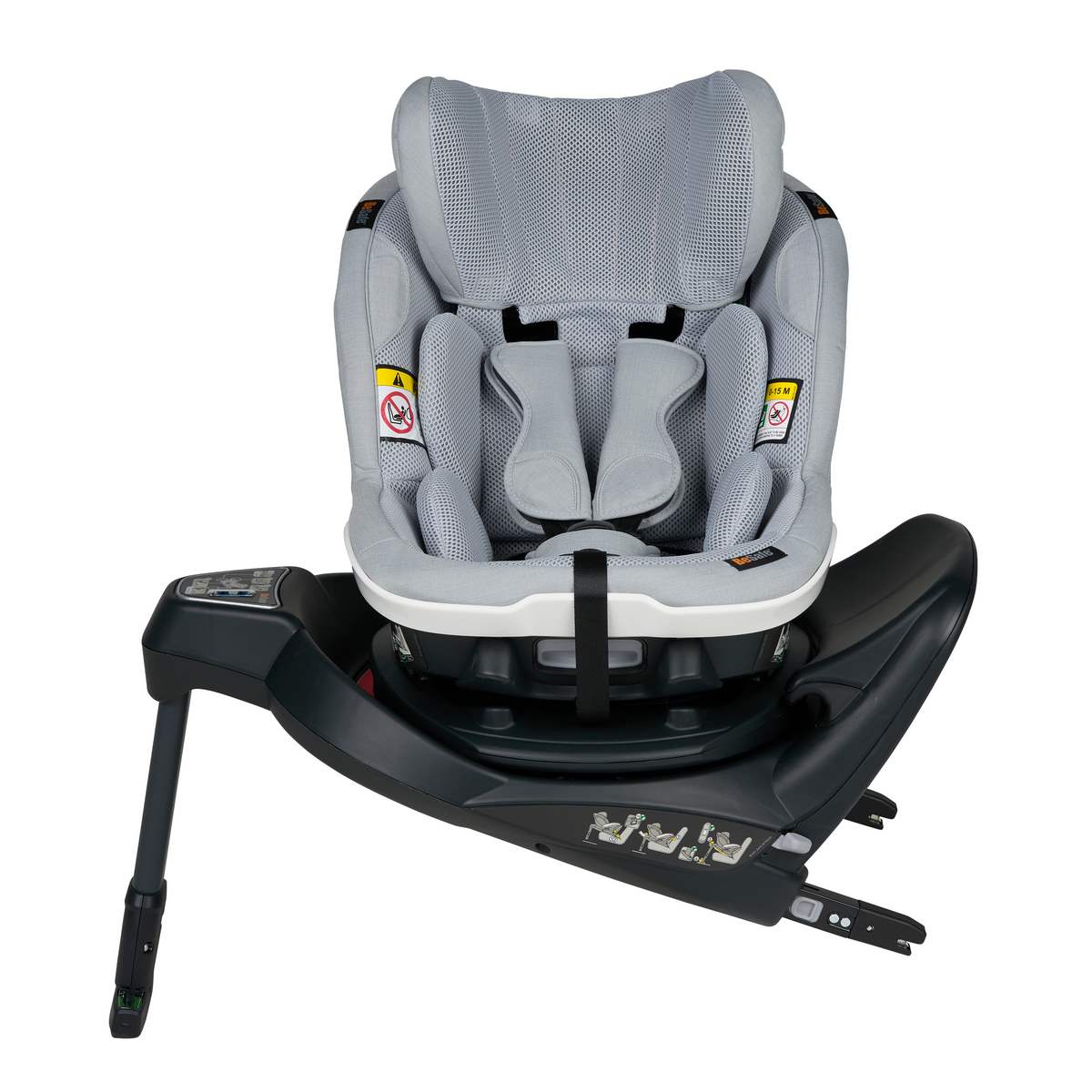
Has your child outgrown the infant car seat? Then it's time for a new seat. The most common choice is a so-called reboarder. This is a rear-facing child seat that is usually installed in the car with an Isofix base station. Your child is secured in the seat with a 5-point harness. The BeSafe iZi Turn i-Size reboarder is a reboarder that is connected to its base. As its name suggests, it can be rotated on the base. It is possible to rotate the seat once through 360° around its own axis. The iZi Turn can be used in and against the direction of travel in the car. However, the i-Size standards stipulate that your child may only be secured in the car facing forwards from the age of at least 15 months. Before that, it is intended to be used against the direction of travel. The manufacturer BeSafe encourages parents to use the rear-facing mode for as long as possible and places great emphasis on legroom and a comfortable seating position. Safe, safest safest! The Isofix safety system makes the reboarder particularly safe and prevents application errors. The visual and acoustic indicators that ensure perfect installation in the car also contribute to this. It is also worth noting that, thanks to the latest technologies, the base can be installed in such a way that your child can sit at the optimum angle. The reboarder is available in two versions. As iZi Turn from 61cm height and as iZi Turn B from birth. Your child is secured in the seat with the five-point harness. The reboarder is available in many beautiful colours and can therefore be perfectly matched to the interior of the car. Features: 360° swivel function integrated Isofix base station headrest and shoulder straps grow with the child in 10 stages Magnetic Belt Assistants™ visual and acoustic indicators on the base Two-Fit Cushions™ 4 adjustable recline positions approved according to: UN R129 (i-Size) Height of the child: rg 61 - 105 cm, vg 88-105 cm Weight: 18 kg Age: approx. 6 months - 4 years Direction of travel: rear-facing or forward-facing Installation: ISOfix Installation - easy thanks to ISOfix Thanks to the installed ISOfix hooks, installing the seat in the car is quick and easy. Simply extend the ISOfix hooks as far as they will go and connect them to the car. Now push the seat as close as possible to the backrest of the seat with light pressure. The support leg can now be folded out and placed on the floor. Once the support leg is securely in place, your child can sit safely in the reboarder and enjoy the journey.Scope of delivery: Besafe iZi Turn i-Size reboarder, Two Fit Cushion, SIP+
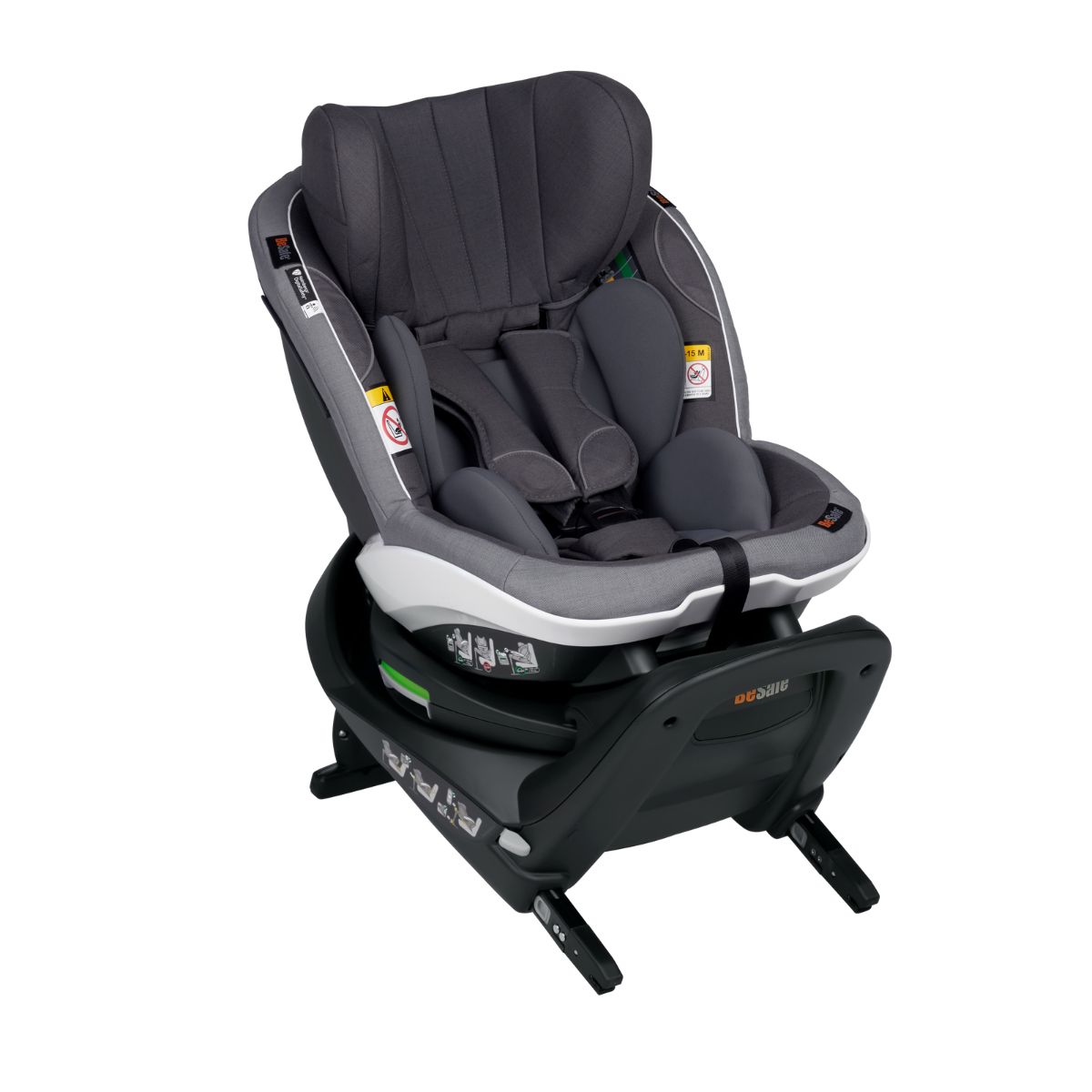
BeSafe and Turn! Safe on the move and swivelling in any direction: the BeSafe iZi Turn M is tailored to the needs of children and parents alike. As a multifunctional car seat, it offers comfort with its various reclining positions as well as safety with its side impact protection systems and buckle detection. The Turn M can be a reliable companion up to the age of four.Features: Height of the child: rearward-facing 61 - 105 cm, forward-facing 88 - 105 cm Max. Max. weight: 18 kg Dimensions: 44 cm x 73 cm x 50 cm Seat height of the headrest in the highest position: 62 cm Direction of travel: forwards and backwards Built-in side impact protection (SIP) in the seat shell, side impact protection (SIP+) Unbuckling detection (alarm system in the event of accidental unbuckling) Headrest with Dynamic Force Absorber Two-Fit Cushions for individual adaptability to the child 10-position adjustable headrest Scope of delivery: BeSafe iZi Turn M i-Size Reboarder, Two-Fit Cushion, SIP+
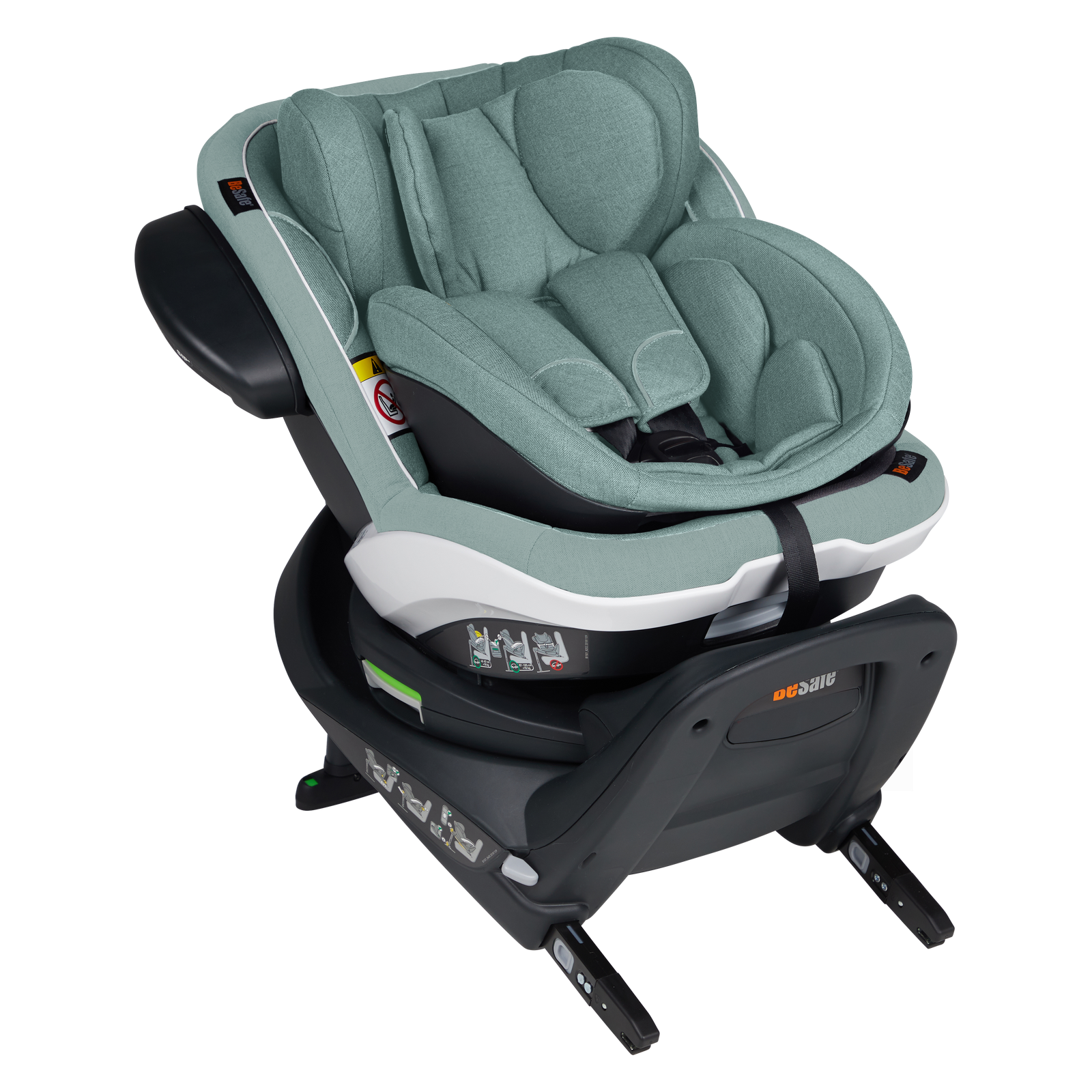
A reboarder in which your child is well secured from birth? No problem for the iZi Twist B i-Size from BeSafe. The reboarder is equipped with a newborn insert that keeps your baby in an optimum position in the seat. This insert can be removed from the seat over time. This means that the reboarder grows with your little one from birth to around the age of four. The practical twist function makes it easier to lift your child in and out of the seat and allows the five-point harness to be optimally positioned and fastened. The Twist offers your child enough legroom to comfortably enjoy the view from the rear window of your car in the opposite direction of travel until the age of four. The reboarder can be lowered to a comfortable resting position in 5 stages to ensure a peaceful sleep and a pleasant journey. With the five-point harness, your child is always optimally secured. Together with the headrest, the harness system grows with your child. The BeSafe iZi Twist B i-Size is the perfect companion from the day your child is born, for parents who want their children to be as safe as possible in the car. Twist it! The BeSafe iZi Twist B i-Size reboarder is a child car seat that is connected to its base. As its name suggests, it can be "twisted" on the base. Unlike the iZi Turn, however, it can only be used to lift the child in and out of the seat. A complete 360° rotation is not possible. The iZi Twist B can only be used against the direction of travel in the car. Securing the reboarder with Isofix makes it particularly safe and helps to avoid application errors. The visual and acoustic indicators installed on the base also contribute to this, ensuring perfect installation in the car. It is also worth noting that, thanks to the latest technologies, the base can be installed in such a way that your child can be seated at the optimum angle, even if the rear bench seat is at an angle. Your child is secured in the seat with the five-point harness. The iZi Twist B is approved in accordance with UN R129, better known as i-Size standards. These high safety standards ensure maximum all-round safety for your child. Features: Magnetic Belt AssistantsTM Newborn Hugger™ Universal Level Technology™ visual and acoustic indicators on the base Ventilation system in the back area 10-way adjustable headrest Approved according to: UN R129 (i-Size) Size of the child. 40 - 105 cm Weight of the child: max. 18 kg Age of the child: from birth to approx. 4 years Direction of travel: rear-facing Installation: ISOfix Child seat weight: 15 kg Child seat dimensions: Length: 44 cm, width: 73 cm, height: 50 cm (headrest in lowest position) Seat height with headrest in highest position: 62 cmScope of delivery: BeSafe iZi Twist B i-Size, Newborn Hugger™, Baby Shell ™ seat reducer, Additional SIP+
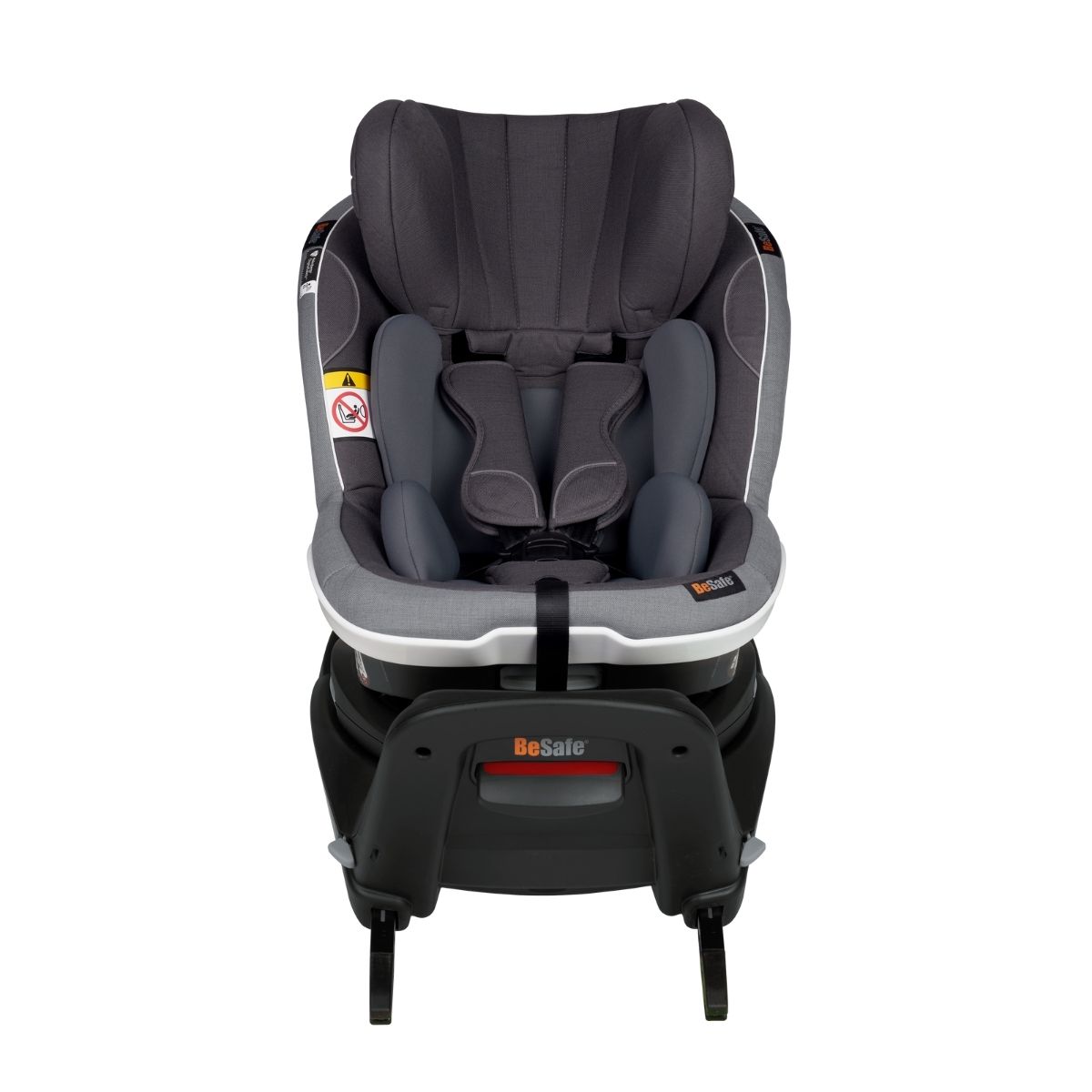
The iZi Twist E-M i-Size is a reboarder from BeSafe with a swivel function. It can be rotated to the side. This makes it easier for you to lift your child in and out of the seat and buckle them in. This child car seat can only be used rearward facing. It is suitable from the age of approx. 6 months. The rear-facing seating position during car journeys up to the age of 4 keeps your child particularly safe. BeSafe recommends maintaining the rear-facing driving position for as long as possible. The seat has a new safety system. The new installation assistant makes installation in the car not only very easy, but also safe. You are guided step by step through the installation process. Only when all steps have been carried out correctly will you be given the green light to drive. If your child unbuckles during the journey, you will be informed by a warning tone. The iZi Twist E-M is installed in the car with Isofix. Features:Height of the child: 61 - 105 cmAge: approx. 6 months - 4 yearsWeight: max. 18 kgWeight: 15 kgHeadrest dimensions in lowest position: L x W x H: 44 x 73 x 50 cmHeadrest dimensions in highest position: L x W x H: 44 x 73 x 62 cmDirection of travel: Rear-facingSwivel functionE-Fit Guider™ helps with correct installationHolmberg's DigitalSafety™ safety systemSIP (side impact protection) and SIP+ (additional side impact protection)Headrest with Dynamic Force Absorber™Headrest and shoulder straps are height-adjustableHeadrest adjustable in 10 positionsMagnetic Belt Assistants™Two-Fit Cushions™4 adjustable recline positionsVentilation systemInstallation: IsofixIntegrated Isofix base stationApproved according to: UN R129 (i-Size)Scope of delivery: BeSafe iZi Twist E-M i-Size reboarder including connected base, additional side impact protection (SIP+), seat reducer
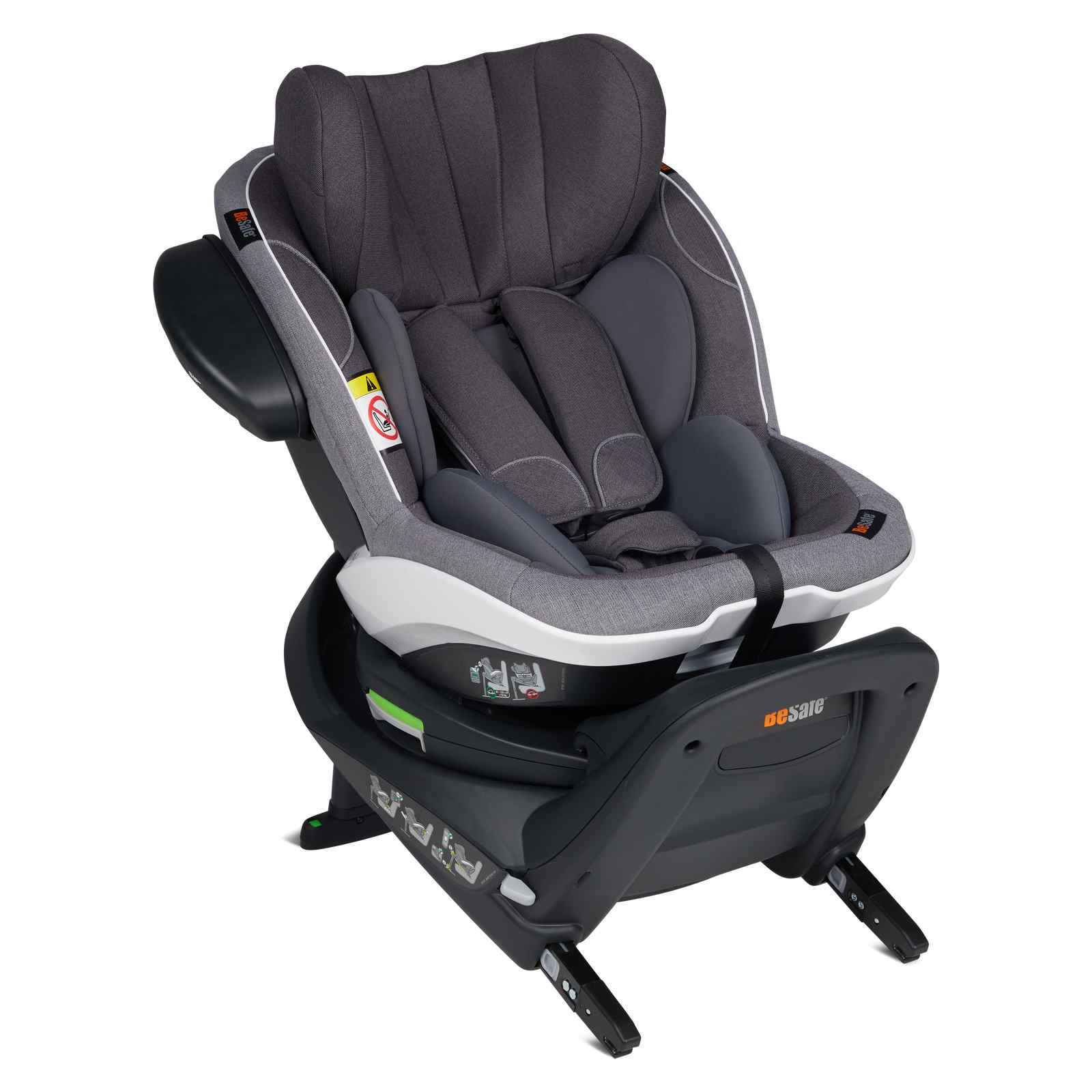
Are you looking for a subsequent child seat for your baby? Is it important to you that your child is secured for as long as possible against the direction of travel in the child car seat and yet you don't want to do without the convenience of being able to turn the seat towards the car door? Then the BeSafe iZi Twist i-Size is exactly the right seat for you. From a height of 61cm, your baby can sit comfortably and safely in the Twist and enjoy the wide view from the rear window of your car. And equipped with the i-Size safety standards, you can always know that your child is in maximum safety on every journey. There's a lot behind it The BeSafe iZi Twist Reboarder is a reboarder connected to its base. As its name suggests, it can be "twisted" (rotated) on the base. However, it can only be used to lift the child in and out of the seat; full 360° rotation is not possible. The iZi Twist can also only be used in the car facing the direction of travel. As soon as you want your child to face in the direction of travel, you will need another seat. The Isofix safety system makes the reboarder particularly safe and prevents application errors. The visual and acoustic indicators, which ensure perfect installation in the car, also contribute to this. It is also worth noting that, thanks to the latest technologies, the base can be installed in such a way that your child can sit at the optimum angle. The reboarder is available in two versions. As iZi Twist from 61cm and as iZi Twist B from birth. Your child is secured in the seat with the five-point harness. The reboarder is available in many beautiful colours and can therefore be perfectly matched to the interior of the car. Features: 10-way adjustable headrest Magnetic Belt AssistantsTM visual and acoustic indicators on the base Ventilation system in the back area Approved according to: UN R129 (i-Size) Size of the child. 61 - 105 cm Weight of the child: max. 18 kg Age of the child: approx. 6 months - 4 years Direction of travel: rear-facing Installation: ISOfix Child seat weight: 15 kg Child seat dimensions: Length: 44 cm, width: 73 cm, height: 50 cm (headrest in lowest position) Seat height with headrest in highest position: 62 cmScope of delivery: BeSafe iZi Twist i-Size child car seat, SIP+ side impact protection, Seat reducer
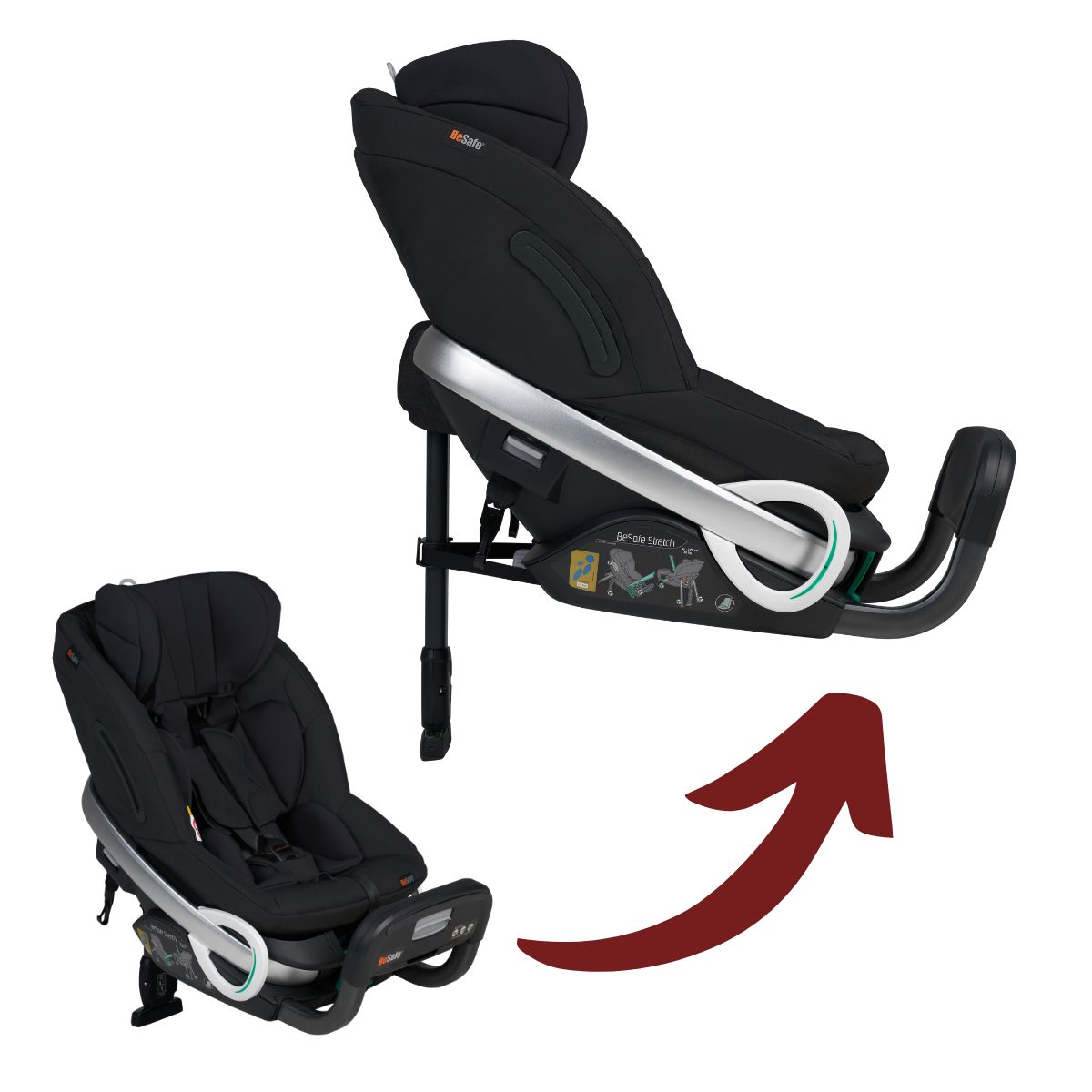
Is it important to you that your child is secured in the car facing the opposite direction of travel for as long as possible? Conventional reboarders only allow this up to the age of approx. 4 years. All these features are hidden in the new Stretch Reboarder from the manufacturer BeSafe. It can be used in the car from the age of six months and grows with your child up to the age of seven. Its particularly large legroom means that even older children can be secured in the opposite direction of travel. Approved according to UN R129 (i-Size), it has the highest possible safety precautions. But why should your child be secured in the car facing the opposite direction of travel up to the age of seven? Travelling against the direction of travel is particularly important in the event of an accident. The energy generated is absorbed by the seat and can be dissipated in a targeted manner, thus relieving the strain on the back and neck spine. Children have an excellent view of what is happening through the rear window and mirrors allow you to communicate easily at all times. The BeSafe Stretch offers children and parents new safety options and a particularly safe driving experience up to the age of seven! Latest technology The BeSafe Stretch reboarder can be used for children from 6 months. With 26 cm of adjustable legroom, it grows with your child up to the age of seven (125 cm, 36 kg). It only travels rearward-facing in the car and is approved in accordance with UN R129 (i-Size) safety standards. Installation in the car with the seat belt is also unbeatable. The Exo Frame specially developed for the Stretch Reboarder secures children weighing up to 36 kg. The accident forces are transferred via the belt, into the frame of the seat and finally via the base into the floor. This means that the seat is hardly deformed in the event of an accident and the forces are transferred away from the seat. Even when the seat is installed and your child is already strapped in, the seat can beadjusted to a reclined position in 5 stages. This means that children of all ages can enjoy a peaceful night's sleep in an ergonomic position. Features: Approval: UN R129 (i-Size) Direction of travel: Rear-facing up to 125 cm and 36 kg Legroom 26 cm Installation with the three-point harness 5 resting positions Weight of the child (maximum): 36 kg Height of the child: 61 - 125 cm Weight of the seat: 11 kg Exo FrameScope of delivery: BeSafe Stretch Reboarder, Two Fit Cushion

Britax Römer Baby-Safe Pro Safe and secure right from the start. In the Baby-Safe Pro from Britax Römer, your child is completely protected and safe. The infant car seat was developed to minimize risks during car journeys. This is ensured by the side impact protection and the easy-to-use 3-point harness. The clearly visible indicators on the base (sold separately) ensure correct installation without application errors. With this feeling of reliable safety, you too can ride more carefree and relaxed. The Baby-Safe Pro grows with your child step by step. As a newborn, it lies protected in the energy-absorbing foam padding of the newborn insert. This can be easily removed as soon as your child has outgrown it (up to approx. 61 cm tall). Depending on the size of your child, the harness can also be adjusted and the headrest can be adapted to your child. A particularly practical feature is that no new base is required to use a follow-up seat; the existing one can simply continue to be used. Let this extremely lightweight infant car seat make everyday life easier for you and your child and benefit from its many practical features. Highlights Flexible on the go To give you constant flexibility, the infant car seat can be easily attached to the Britax Römer Smile 5Z baby carriage or a baby carriage from many other leading manufacturers. If your child falls asleep during the car journey, they can continue to snooze undisturbed while you are on the move. Large canopy A large canopy is extremely practical in any weather, as it not only protects your child from the sun, but also from the wind. It also acts as a protective shield against restlessness, giving your little one a safe place to dream, rest and relax. The canopy has UPF 50+ protection and can be individually adjusted independently of the carry handle. Ergo Recline Regardless of whether you are traveling with your child in the car or elsewhere, it is crucial that they can always lie and sleep comfortably and in an ergonomically optimal position. The Ergo Recline function allows your baby to gently transition to a flatter lying position. This function ensures an opening of the airways and supports the healthy development of the spine. Use with a base A base makes your everyday life much easier. The infant car seat can be easily installed on the base and rotated towards the car door. The release button also rotates. This makes it child's play to put your baby in and buckle them in. Indicators signal correct installation to minimize the risk of application errors. If your car does not offer an ISOfix option or you are switching between vehicles, the infant car seat can also be installed using the vehicle's 3-point belt. Technical data and features Use: From birth - 85 cm (approx. 15 months) Dimensions: 62.5 cm x 44 cm x 65.5 cm Weight: 3.9 kg Cover: Removable and machine washable Direction of travel: Rear-facing Installation: i-Size (R 129) Compatible with Base : Britax Römer Vario Base 5Z, Britax Römer Flex Base iSense, Britax Römer Flex Base 5Z Compatible with stroller: Britax Römer Smile 5Z Not compatible with Fox 5 Scope of delivery: Britax Römer Baby-Safe Pro, newborn insert
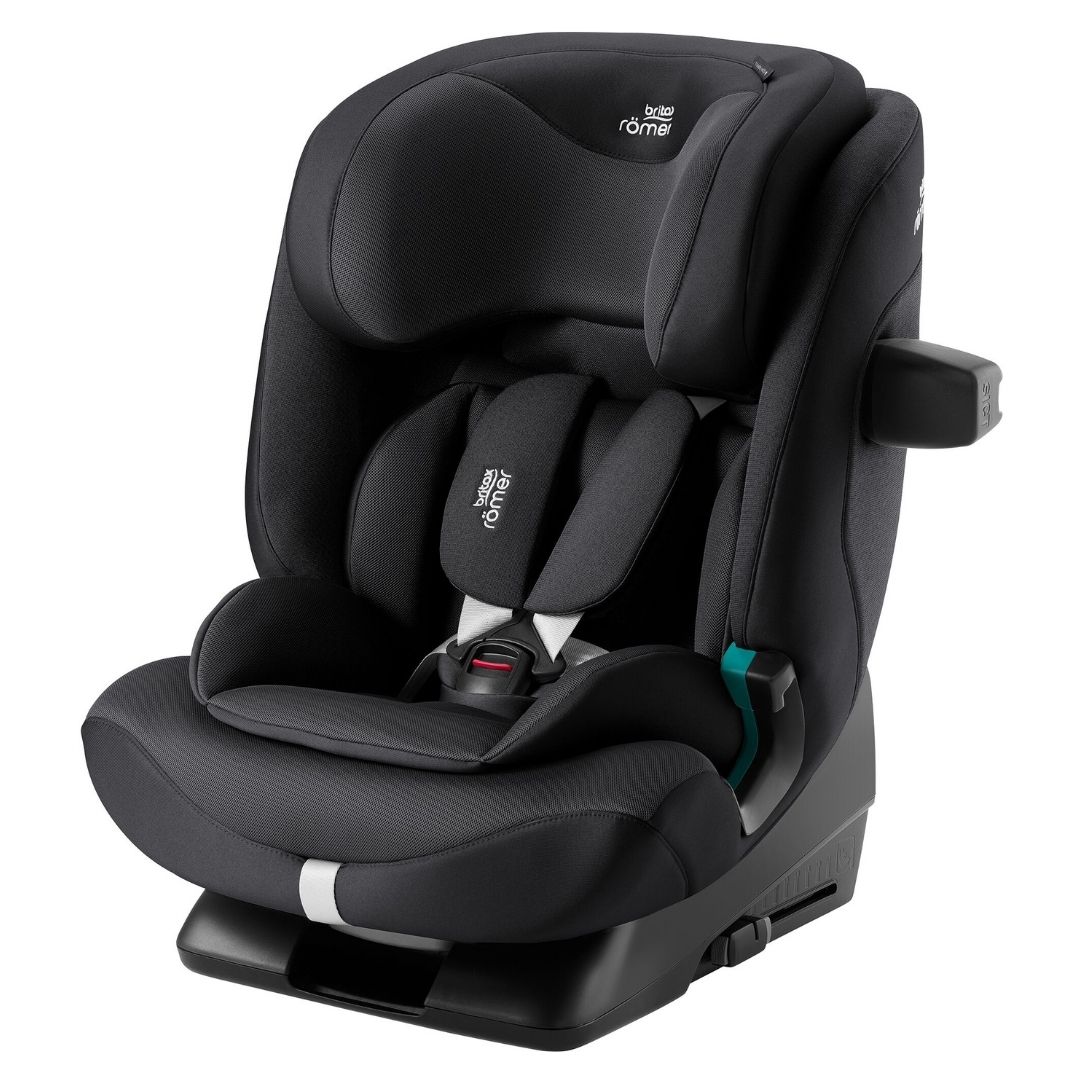
Der Britax Advansafix Pro ist wie ein zuverlässiger Freund, der Ihre Familie viele Jahre lang sicher und geborgen auf Reisen begleitet. Dieser praktische Begleiter wächst mit Ihrem Kind und passt sich von 15 Monaten bis 12 Jahren perfekt an – von einem 5-Punkt-Gurtsystem für die Kleinsten bis hin zu einem 3-Punkt-Fahrzeuggurt für die größeren Kinder. Bei einem Aufprall verteilt das clevere 5-Punkt-Gurtsystem die Kräfte sanft auf Schultern, Hüften und Becken, während das kuschelige Schaumstoffkissen den empfindlichen Hals Ihres kleinen Schatzes schützt und gleichzeitig als ein extra Wohlfühl-Kissen dient. Der zusätzliche vierte Befestigungspunkt am Beckengurt sorgt für noch mehr Sicherheit, ohne dabei die Bewegungsfreiheit einzuschränken. Mit der praktischen EasyRecline-Funktion können Sie den Sitzwinkel ganz einfach anpassen, damit Ihr Kind auch auf langen Fahrten sicher und bequem in der Ruheposition entspannen kann. Der Advansafix Pro erfüllt die neuesten i-Size Sicherheitsstandards (UN R129), sodass Sie sich immer sicher und entspannt fühlen können. Und das Beste: Sie können ihn in drei verschiedenen Varianten wählen und ihn ganz nach Ihrem Geschmack anpassen! Drei Varianten der Kollektion 2025Die Classic Variante beeindruckt durch ihre zeitlosen Farben, die Ihrem Advansafix Pro einen eleganten und klassischen Look verleihen. Zudem zeichnet sich diese Variante durch ein neues, ansprechendes Design der Bezüge aus, das sowohl optisch ansprechend als auch funktional ist. Die überarbeitete Gestaltung sorgt nicht nur für einen modernen und stilvollen Auftritt, sondern auch für zusätzlichen Komfort und ein noch angenehmeres Fahrgefühl für Ihr Kind.Die Style Variante des Advansafix Pro bietet ein besonders angenehmes Sitzgefühl durch ihre weiche Einlage, die für zusätzlichen Komfort sorgt. Sie haben die Freiheit, aus einer Vielzahl von Farben zu wählen, die am besten zu Ihrem Stil und Ihrer Einrichtung passen. Der Bezug besteht aus hochwertigem Mesh-Gewebe, das hervorragende Atmungsaktivität bietet und auch an warmen Tagen angenehm kühl und komfortabel bleibt. Dadurch bleibt Ihr Kind stets gut belüftet und genießt eine angenehme Fahrt, ganz gleich bei welchem Wetter. Die Lux Variante ist der ultimative Blickfang und setzt mit ihrem eleganten Design ein echtes Statement. Sie haben die Auswahl aus einer Vielzahl von stilvollen Farben, die es Ihnen ermöglichen, den Kindersitz perfekt an Ihren persönlichen Geschmack und Ihr Fahrzeuginterieur anzupassen. Besonders hervorzuheben sind die edlen Lederdetails, die dem Sitz eine luxuriöse Note verleihen und ihn zum schicksten Modell seiner Reihe machen. Mit der Lux Variante entscheiden Sie sich für einen Kindersitz, der nicht nur durch seine Funktionalität, sondern auch durch seine außergewöhnliche Ästhetik besticht. Highlights Wächst mit Ihrem Kind mit Der Kindersitz begleitet Ihr Kind von 15 Monaten bis zum 12. Lebensjahr und wächst mühelos mit ihm mit, ohne dass ein neuer Sitz nötig ist. Die einfache Anpassung des weich gepolsterten Sitzes und der verstellbaren Kopfstütze garantiert eine perfekte Passform. Der Wechsel vom 5-Punkt-Gurtsystem zum Autosicherheitsgurt ist unkompliziert, und bei Bedarf kann die Sitzposition schnell geändert werden, damit auch größere Kinder bequem schlafen können. Dank der durchdachten Beckengurtführung und dem komfortablen Schulterpolster sitzt Ihr Kind immer sicher und bequem. Premium "Full-Cover" Bezug Der Kindersitz ist mit einem praktischen "Full-Cover"-Bezug ausgestattet, der ihn rundum schützt und dafür sorgt, dass er auch nach jahrelangem Einsatz wie neu aussieht. Dieser Bezug lässt sich ganz einfach abnehmen und in der Waschmaschine reinigen, sodass Sie sich keine Gedanken über Verschmutzungen wie verschüttete Getränke oder kleine Missgeschicke machen müssen. So können Sie sich entspannt auf das Wesentliche konzentrieren, während der Sitz stets sauber und gepflegt bleibt. Sichere Installation Die Befestigung des Kindersitzes erfolgt durch ein durchdachtes System aus ISOFIX-Armen und dem Top Tether. Diese Kombination sorgt dafür, dass der Sitz im Falle eines Unfalls sicher und stabil bleibt. Der Top Tether fixiert den Sitz zuverlässig, wodurch unerwünschtes Wackeln minimiert wird und besonders der Kopf und Nacken Ihres Kindes optimal geschützt sind. Die ISOFIX-Arme lassen sich einzeln bedienen, was die Installation des Kindersitzes denkbar einfach und unkompliziert macht. Seitenaufprallschutz - SICT Durch das Anbringen des zusätzlichen Seitenaufprallschutzes auf der zur Tür gewandten Seite Ihres Kindersitzes bieten Sie Ihrem Kind noch umfassenderen Schutz während der Fahrt. Diese fortschrittliche Technologie leitet im Falle eines Aufpralls die Kräfte effektiv von Ihrem Kind ab und kann die Aufprallkräfte um bis zu 40 % verringern, wie interne Sicherheitstests und Simulationen von Britax Römer zeigen. Technische Daten und Eigenschaften Zulassung: UN R129/03. i-size Eignung 76 – 150 cm, bzw. 15 Monate -12 Jahre (vorwärtsgerichtet) Installation: ISOFIX & Top Tether (76 - 105 cm) | ISOFIX & 3-Punkt-Gurt (100 - 150 cm) | 3-Punkt-Gurt (100 - 150 cm) Maße: 60-83 cm x 44 cm x 48 cm Gewicht: 10 kg Besonderheiten Premium „Full-Cover“ Bezug Sicherheitseigenschaften: SecureGuard, XP-PAD, SICT Gurtlänge: Verstellgurt + 10 cm zum Vorgängermodell, Schulter- / Hüftgurt 80 cm lang 5-Punkt-Gurt kann bis zu einem Körpergewicht von 22 kg verwendet werden Meshbezug (nur mit der Style Variante) Lederdetails (nur mit der Lux Variante)

Britax Römer Baby-Safe 3 i-Size infant carrier With the Baby-Safe 3 i-Size baby car seat from Britax-Römer you can enjoy the exciting baby time and rely on the high quality and safety of the baby car seat. Your baby can sleep comfortably in the ergonomic reclining position and enjoy the car ride. You can choose whether you want to install the infant carrier with the car belt or whether you want to purchase the Britax-Römer Flex Bsse iSense. The base offers even more safety and other great features. For example, you can turn the infant carrier on the base to the door side and install a reboarder on the base later. You can read about the features of the infant carrier without the base on this page. Features of the Baby-Safe 3 infant carrier Ergonomic reclining position To ensure that your baby has the healthiest possible posture when lying in the infant carrier, the infant carrier has technology that allows you to adjust the reclining position to different flatnesses and to suit the size of your child. For this purpose, the child seat includes a removable infant carrier. Flexible use You can choose to install the Baby-Safe 3 infant carrier using the car seat belt, or you can purchase the Flex Base iSense to go with it. The base is available separately from us. In addition, you can install the infant carrier on a pushchair and thus quickly switch from the car and remain mobile on foot. Adjustable in many ways You can adjust the carry handle backwards to easily place your child in the infant carrier or lift it out. If you place the shell on the floor, you can use the handle to prevent rocking. The headrest and shoulder straps can also be adjusted with one hand, so you can always adapt the Baby-Safe 3 to the size of your growing baby. Premium covers The covers of the Baby-Safe 3 are comfortable and soft. Another advantage is that the covers can be quickly removed if they get dirty, for example. Of course, they are also machine washable. The sun canopy is also premium quality and has UPF 50+ sun protection. Technical data of the Baby-Safe 3 infant carrier from Britax-Römer suitable for 40-83 cm or 0-13 kg or birth to 15 months can be used rearward facing Dimensions 58 cm high, 44 cm wide, 67 cm deep Weight 4,6 kg Installation with the car belt with the Flex Base iSense (not included in delivery, ISOFIX required)
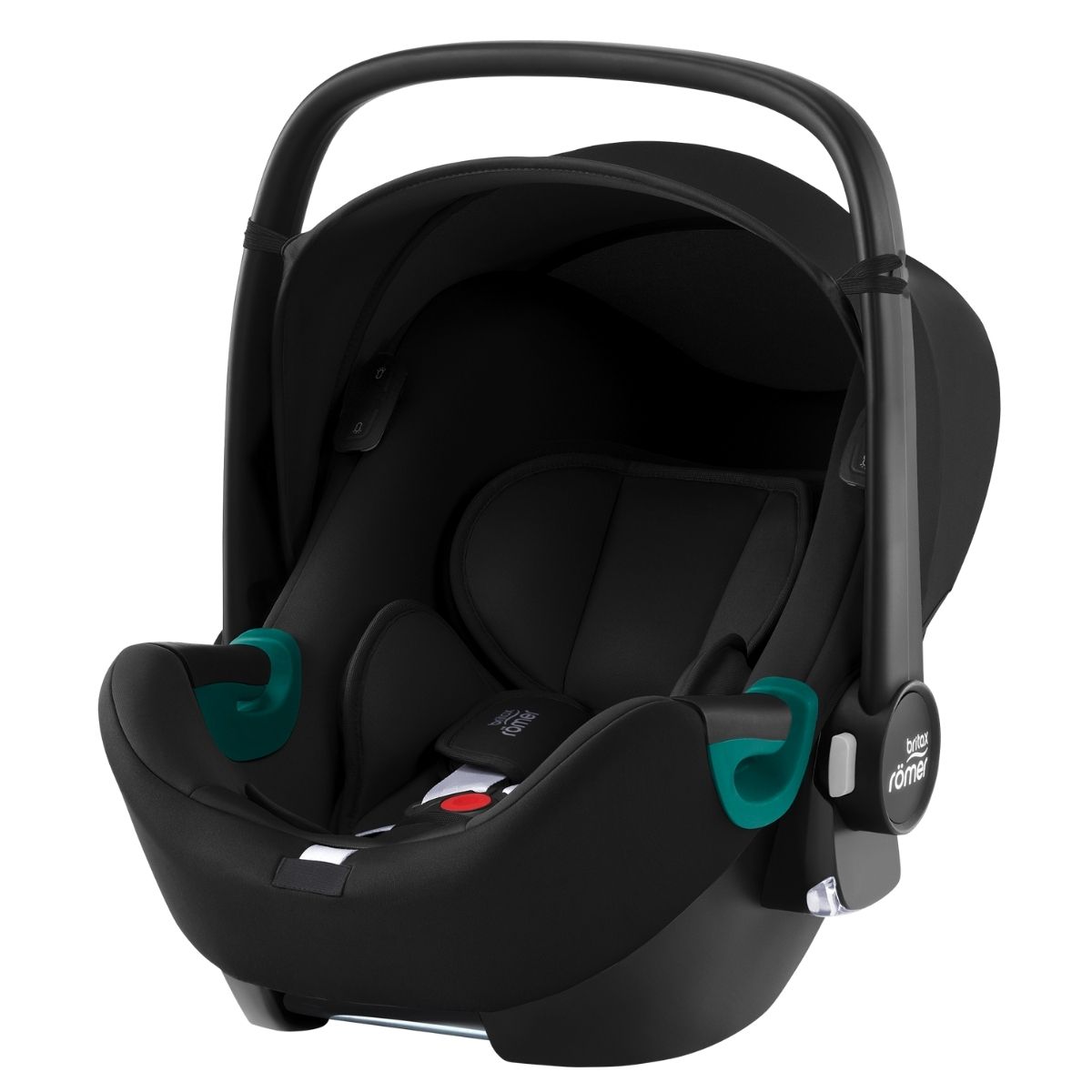
Britax Römer Baby-Safe iSense infant carrier The Baby-Safe iSense infant carrier offers your baby optimum comfort and safety from birth. You can either attach it with the car belt if your vehicle does not have ISOFIX, or you can buy the Flex Base iSense, available separately, and install the infant carrier on the base. A base is the variant that offers even more safety. The Baby-Safe iSense baby car seat convinces with great details and functions. You can read about these in detail in the following section. Among other things, the baby car seat has three different light functions that make walking in poor visibility even safer and installation and removal even easier. With the two new colours Atlantic Green and Fossil Grey, Britax-Römer is taking a big step towards a sustainable future. See for yourself! Features of the Baby-Safe iSense infant carrier Clever lighting The baby car seat has three different lights. When you use the infant carrier on the pram in the dark, lights help to increase safety and your visibility. The installation lights turn on automatically when installing if needed and the inner lights help your baby to see. Flat lying position The most ergonomic position for babies is the flat lying position. This is possible in the Baby-Safe iSense infant carrier. For this purpose, the headrest can be adjusted to the size of your baby, which enables a flat lying position. The shoulder straps adjust automatically with the headrest. Click and Go system The installation on the base or the pram works with just one click. Britax has integrated the Click and Go system so that uninstalling is also particularly easy and can be done without bending down. This allows you to remove the infant carrier in one easy step without straining your back. Premium covers The covers are extra nice and soft. They now have a better fit, making them even more comfortable than before. They are also quick and easy to remove. It can happen that in hectic everyday life the drink spills. Of course, the covers are machine washable. Recycled baby seat fabrics When you choose the colour for your Baby-Safe iSense infant carrier, this gives you a choice of two types of fabric. Most colours are associated with a "standard" fabric. These fabrics are very high quality, soft and comfortable. The other option is the colours "Atlantic Green" and "Fossil Grey". Because these two colours are connected with the new recycled fabrics. Here, recycled polyester in the form of plastic bottles is processed into yarn and fabric is produced from it. In this way Britax-Römer takes another step towards sustainability. Technical data of the Baby-Safe iSense infant carrier suitable for: 40 to 83 cm or birth to 15 months or 0 to 13 kg Dimensions: 58 cm high, 44 cm wide, 67 cm deep Weight: 4.8 kg Installation: either with the car belt or the Flex Base iSense (ISOFIX required) Sun canopy with UPF 50+ Carrying handle adjustable to the rear Safety lights, interior lights and recessed lights 5-point harness system Headrest easily adjustable Installation and removal with just one click Included in delivery: Britax-Römer Baby-Safe iSense and removable newborn insert
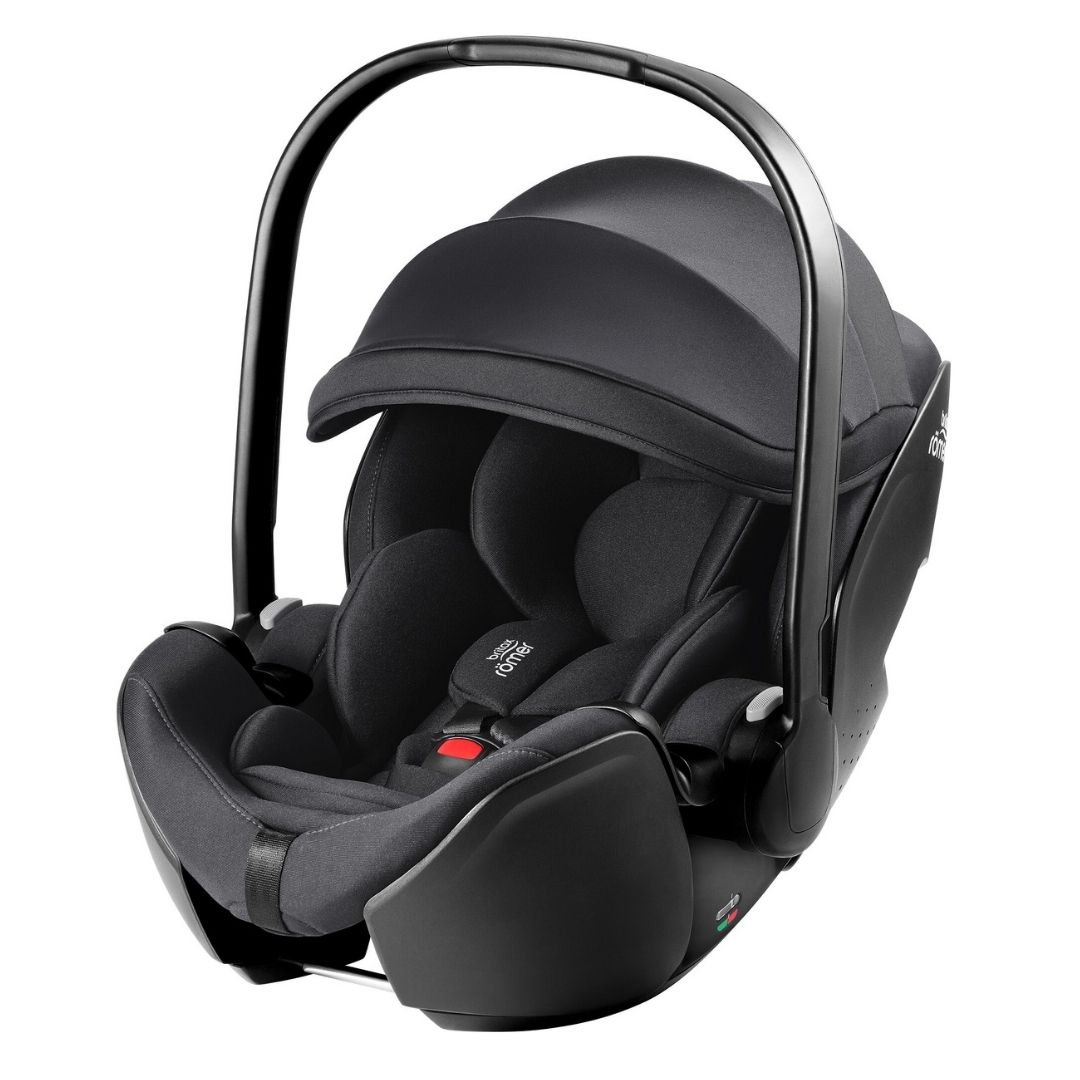
Die BABY-SAFE PRO Babyschale ist die leichteste und innovativste Babyschale von Britax Römer, die Ihr Kleines von Anfang an sicher und geborgen während jeder Autofahrt hält. Die Ergo Recline-Funktion sorgt für eine flachere und ergonomischere Liegeposition, was die gesunde Entwicklung der Wirbelsäule unterstützt und die Atemwege offen hält. Mit ihrem zuverlässigen Seitenaufprallschutz und dem einfach zu bedienenden 3-Punkt-Gurt minimiert die Babyschale die Risiken während der Autofahrt. Der BABY-SAFE PRO wächst mit Ihrem Kind mit. In den ersten Wochen liegt Ihr Baby behütet im energieabsorbierenden Schaumstoffpolster des Neugeboreneneinsatzes. Sobald Ihr Kleines größer wird (bis ca. 61 cm Körpergröße), kann der Einsatz einfach entfernt werden. Der Gurt und die Kopfstütze lassen sich kinderleicht an die Größe Ihres Lieblings anpassen. Mit nur 3,9 kg ist die BABY-SAFE PRO extra leicht und erleichtert Ihnen den Alltag. Der verstellbare Griff ermöglicht ein einfaches Heben und Abstellen der Babyschale, und das große Sonnenverdeck mit UPF 50+ schützt Ihr Baby vor Sonne und Wind. Ein maschinenwaschbarer Sitzbezug sorgt dafür, dass die Babyschale immer sauber und frisch bleibt. Mit der separat erhältlichen VARIO BASE 5Z gestaltet sich der Alltag noch flexibler und sicher. Die BABY-SAFE PRO passt sich euren Bedürfnissen an und bietet Ihrem Baby maximalen Komfort und Sicherheit auf jeder Reise. Mit all diesen praktischen Eigenschaften wird jede Fahrt zu einem entspannten Erlebnis für Ihre Familie!Technische Daten und Eigenschaften Nutzung: Von Geburt- 85cm (ca. 15 Monaten), bis ca. 13 kg Maße: 62,5 cm x 44 cm x 65,5 cm Gewicht: 3,9 kg Ergo-Recline Liegefunktion Fahrtrichtung: Rückwärtsgerichtet optimierte Winkelanpassung Neugeboreneneinsatz mit energieabsorbierenden Schaumstoffpolster 3-Punkt-Gurt wächst mit: variables Gurtsystem und verstellbare Kopfstütze Bezug: Abnehmbar und maschinenwaschbar Installation auf den Basisstationen VARIO BASE 5Z, FLEX BASE 5Z oder FLEX BASE iSENSE oder mit dem Fahrzeuggurt kann auch in der Liegepositionen gegurtet werden Kompatibel mit Base : Britax Römer Vario Base 5Z, Britax Römer Flex Base iSense, Britax Römer Flex Base 5Z Kompatibel mit Kinderwagen: Britax Römer Smile 5Z (nicht kompatibel mit Fox 5) Lieferumfang: Britax Römer Baby-Safe Pro, Neugeboreneinsatz
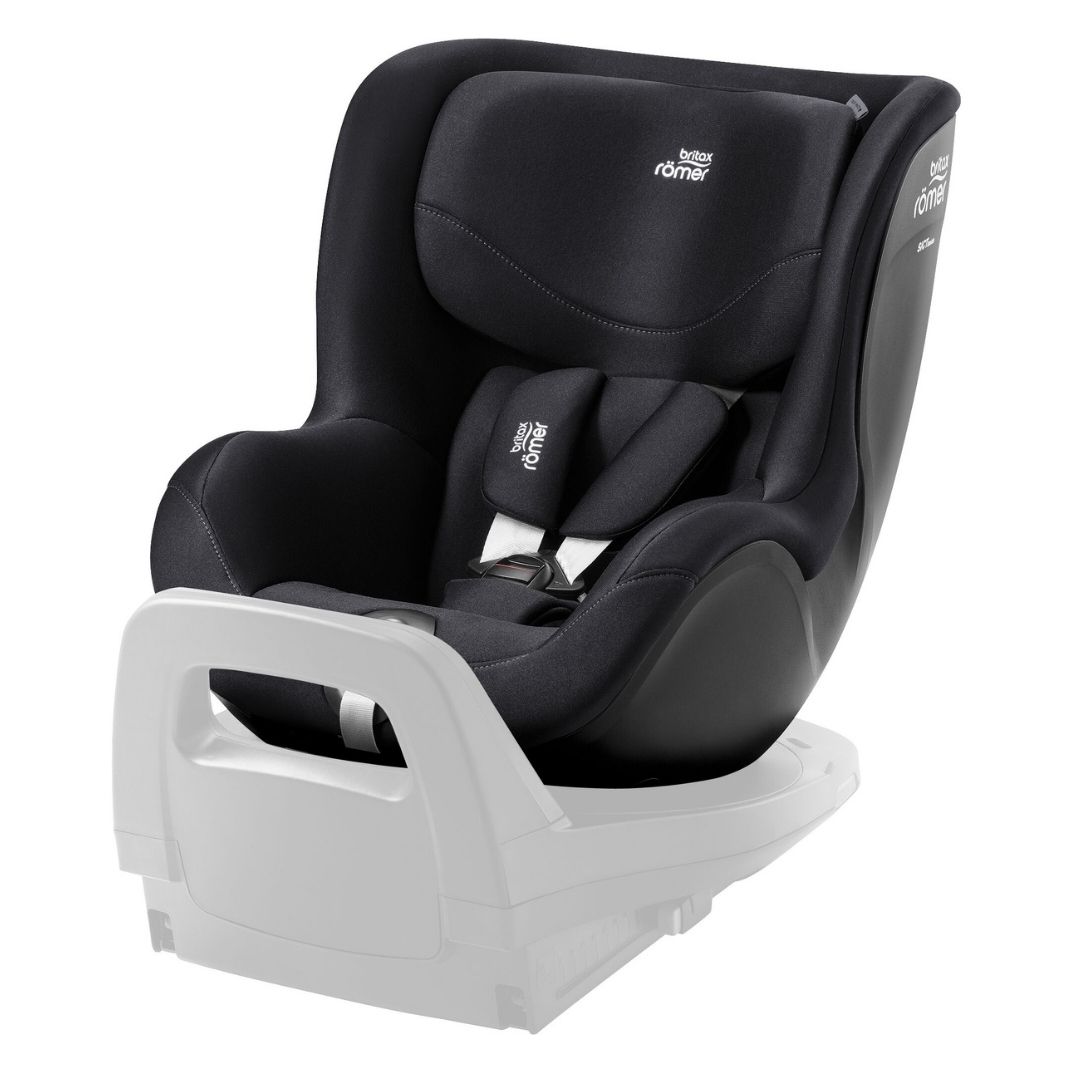
Der DUALFIX 5Z Reboarder begleitet Ihr Kind sicher und bequem vom Alter von 3 Monaten bis zu 4 Jahren. Er bietet 12 Ruhepositionen (6 vorwärts- und 6 rückwärtsgerichtet) sowie eine V-förmige Kopfstütze, die Platz und Schutz bietet, während Ihr Kind wächst. Die 360°-Drehfunktion ermöglicht ein einfaches Ein- und Aussteigen, auch in engeren Parklücken. Für zusätzliche Sicherheit sorgt das 5-Punkt-Gurtsystem, das die Aufprallkräfte gleichmäßig verteilt, und die weichen Spezial-Schulterpolster, die den Sitzkomfort erhöhen und leicht zu reinigen sind. Das Stützbein der Basis (nicht im Lieferumfang enthalten) sorgt für zusätzliche Stabilität und reduziert die Kippbewegungen im Falle einer Kollision; ein Signalton informiert bei unsachgemäßer Installation. Der Sitzbezug ist maschinenwaschbar und kann einfach abgenommen werden, ohne das Gurtsystem zu entfernen. Der DUALFIX 5Z schützt Ihr Kind zusätzlich bei Seitenkollisionen durch die SICT inside Technologie und ermöglicht durch die Rückwärtsgerichtete Position eine erhöhte Sicherheit bei Frontalkollisionen. Mit dem Dualfix 5Z erwerben Sie ein rundum sorglos Paket! Drei Varianten der Kollektion 2025 Das Classic Design verleiht Ihrem Dualfix 5Z eine zeitlose Eleganz und einen eleganten Charakter. Das geschmackvoll ausgewählte Farbdesign bringt eine klassische Note in den Sitz, die stets modern und stilvoll bleibt. Ganz nach dem Motto „Weniger ist mehr“ verbindet es schlichtes Design mit anspruchsvoller Ästhetik. Das Style Design bringt eine frische und durchdachte Ästhetik mit sich. Die Bezüge bestehen aus drei liebevoll aufeinander abgestimmten Premium-Stoffen, die nicht nur toll aussehen, sondern auch super praktisch sind. Besonders kuschelig ist das weiche Mesh-Gewebe, das für eine angenehme Luftzirkulation sorgt und lange Fahrten noch gemütlicher macht. Je nach Modell gibt es noch zusätzliche süße Features, die den Komfort und die Funktionalität weiter verbessern und jede Reise noch schöner gestalten.Der Dualfix 5Z Reboarder präsentiert sich auch im schicken LUX Design, das durch seine erstklassigen Bezüge begeistert. Diese bestehen aus drei harmonisch aufeinander abgestimmten Premium-Stoffen, die zu 70-100 % aus recyceltem Material gefertigt sind – darunter 20 % Seawool, ein innovativer Stoff aus recyceltem Polyester, der aus PET-Flaschen und Austernschalen gewonnen wird. Das elegante Design wird durch eine besondere 3D-Sternprägung und feine Kunstleder-Details abgerundet, die dem Sitz eine exklusive Haptik verleihen! HighlightsLänger rückwärts FahrenDer DUALFIX 5Z sorgt dafür, dass Ihr kleiner Schatz bei Frontalkollisionen besonders gut geschützt ist, da er länger rückwärtsgerichtet verwendet werden kann, was von Experten empfohlen wird. Dadurch werden die Aufprallkräfte sanft auf den gesamten Körper verteilt, was die Sicherheit Ihres Kindes erhöht. Mit der separat erhältlichen Base kann der Sitz sogar um 360° gedreht werden, wodurch das Ein- und Aussteigen ganz unkompliziert und kinderleicht wird.Sicherheit an erster StelleDer Britax Römer Dualfix 5Z bietet ausgezeichneten Schutz bei einem Seitenaufprall dank der integrierten SICT-Technologie, die die Aufprallkräfte abmildert und vom Kind wegleitet. Die V-förmige Kopfstütze schützt den Hals des Kindes und bietet gleichzeitig Platz für Wachstum. Kopfstütze und Gurt lassen sich schnell und einfach gleichzeitig verstellen, um stets eine bequeme und sichere Passform zu gewährleisten. Bequem unterwegsDer Rückhaltebügel des VARIO BASE 5Z (nicht im Lieferumfang enthalten) schützt Ihr Kind bei einem Unfall, indem er das Kippen des Sitzes verhindert, und sorgt durch seine kompakte Größe für mehr Beinfreiheit – ideal für lange Reisen und das bequeme Tragen. Der DUALFIX 5Z macht jede Fahrt zum Vergnügen, da er über viele gemütliche Ruhepositionen verfügt: Wählen Sie aus sechs vorwärts- und sechs rückwärtsgerichteten Positionen, damit Ihr kleiner Schatz bequem entspannen oder neugierig die Welt entdecken kann. So reisen Sie entspannt, während Ihr Kind happy und gut gelaunt bleibt!5-Punkt-Gurtsystem Das 5-Punkt-Gurtsystem bietet bei einem Zusammenstoß optimalen Schutz da es sanft die Aufprallkräfte auf Schultern, Hüften und zwischen den Beinen verteilt. Die weichen Spezial-Schulterpolster des DUALFIX 5Z halten Ihr Kind sicher und bequem und sind dabei so kuschelig, dass sie die Bewegungen des kleinen Schatzes schön dämpfen. Sollte mal etwas daneben gehen, lassen sich die Polster ganz einfach abnehmen und waschen – für ein rundum glückliches und sicheres Fahrvergnügen!Technische Daten und EigenschaftenAlter: 3 Monate- 4 Jahre (61-105 cm) Gewicht: 5,2 kg Maße: 48 cm x 44 cm x 74 cm Belastung Sitzeinheit: bis 19kg Vorwärtsgerichteter Einbau: 76-105 cm Rückwärtsgerichteter Einbau: 61- 105 cm Bezüge abnehmbar und waschbar Seitenaufraprallschutz mehrfach verstellbare Ruhepositionen 5-Punkt-Gurtsystem Neugeboreneneinsatz inklusive Meshbezug (nur in der Style Variante) Lederdetails (nur in der Lux Variante) Lieferumfang: Britax Römer Dualfix 5Z Reboarder (ohne Base) Kompatibel mit: Britax Vario Base, Britax Flex Base 5Z
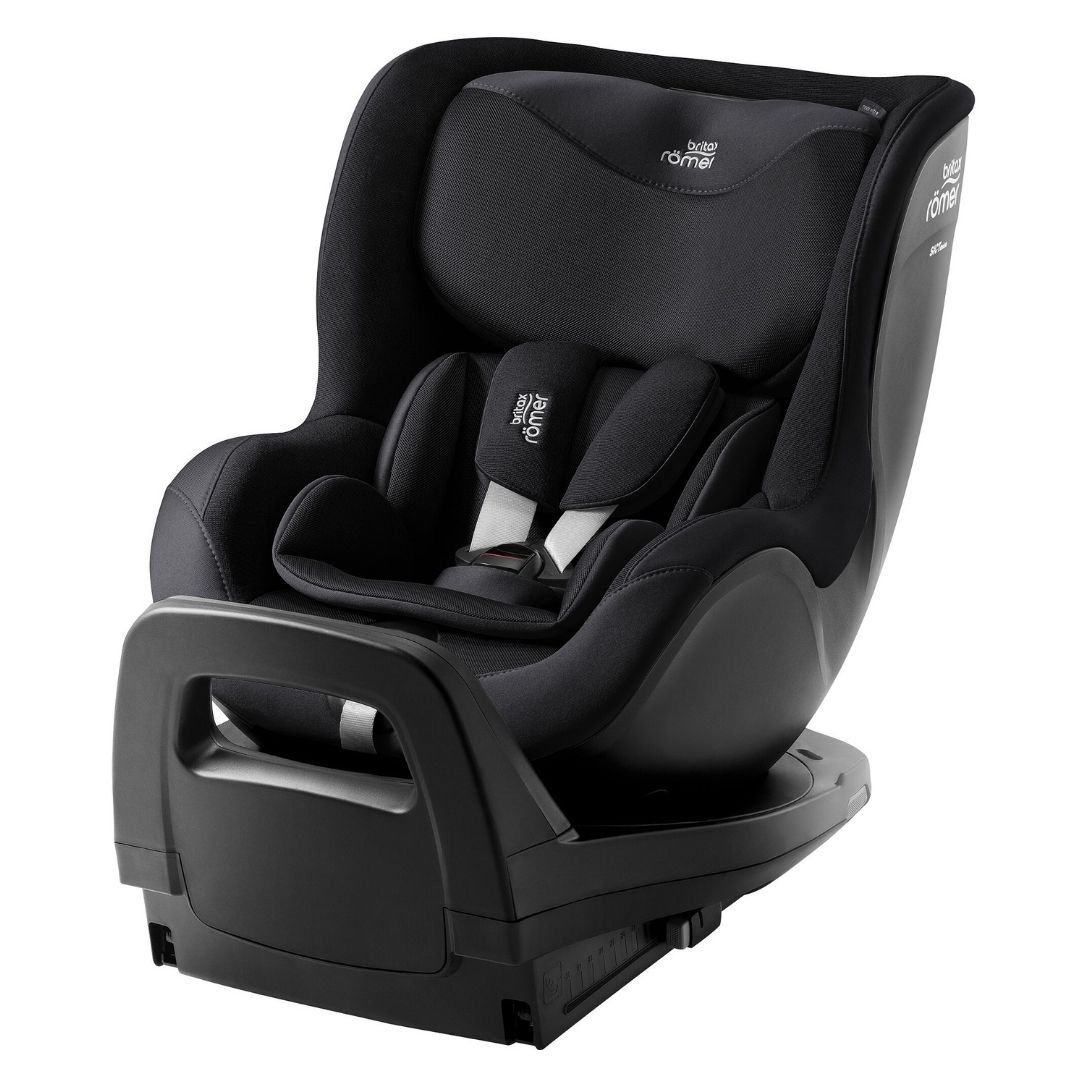
Der Britax Römer Dualfix Pro M ist ein wunderbarer Kindersitz, der für kleine Abenteuer von etwa 3 Monaten bis 4 Jahren (61 bis 105 cm) gemacht ist. Mit seiner praktischen 360-Grad-Drehfunktion wird das Ein- und Aussteigen zum Kinderspiel, selbst in engen Parklücken. Der Sitz schützt Ihr Kind besonders gut: Die V-förmige Kopfstütze hält den kleinen Kopf sicher bei einem Seitenaufprall, während die weichen Schulterpolster sanft die Aufprallkräfte dämpfen und zusätzlichen Komfort bieten. Dank der verstellbaren Ruhepositionen – sechs nach vorne und sechs nach hinten – kann Ihr kleiner Schatz immer bequem entspannen, ob bei einem Nickerchen oder beim Staunen durch das Fenster. Der Dualfix Pro M sorgt auch bei Frontalkollisionen für Sicherheit, da er eine längere rückwärtsgerichtete Nutzung ermöglicht, was Experten empfehlen. Die Installation ist einfach mit dem ISOFIX-System und einem höhenverstellbaren Stützbein, das für extra Stabilität sorgt und sich leicht einstellen lässt. Und wenn mal etwas schiefgeht, lässt sich der waschbare Bezug schnell reinigen. Der Dualfix Pro M vereint Sicherheit, Komfort und Bequemlichkeit und macht jede Fahrt zu einem angenehmen Erlebnis für Eltern und Kinder!Drei Varianten der Kollektion 2025CLASSICDie Classic Design bringt eine zeitlose Eleganz in die Optik Ihres Dualfix Pro M. Ihr raffiniertes Farbdesign verleiht dem Sitz einen klassischen Charme, der nie aus der Mode kommt. Besonders bemerkenswert ist das neu gestaltete Bezugsmuster, das sowohl optisch ansprechend als auch praktisch ist. Diese Kombination aus zeitgemäßer Gestaltung und funktionalen Details sorgt dafür, dass Ihr Kind nicht nur stilvoll sitzt, sondern auch in einem besonders komfortablen und gemütlichen Umfeld reist.STYLEDas Style Design der Bezüge begeistert durch seine frische Ästhetik und durchdachte Funktionalität. Die Bezüge bestehen aus drei verschiedenen, farblich abgestimmten hochwertigen Stoffen, die nicht nur optisch ansprechend sind, sondern auch hervorragende praktische Eigenschaften bieten. Besonders hervorzuheben ist das feine und weiche Mesh-Gewebe, das für eine angenehme Luftzirkulation sorgt und somit für zusätzlichen Komfort auf langen Fahrten sorgt. Je nach Modell können noch weitere zusätzliche Eigenschaften hinzukommen, die den Komfort und die Funktionalität weiter verbessern.LUXDas bewährte und elegante LUX Design des Dualfix Pro M besticht durch seine hochwertigen Bezüge, die aus drei verschiedenen, farblich abgestimmten Premium-Stoffen gefertigt sind. Diese Stoffe bestehen zu 70-100 % aus recyceltem Garn, darunter 20 % Seawool – ein innovatives Material aus recyceltem Polyester, das aus PET-Flaschen und recycelten Austernschalen gewonnen wird. Das stilvolle Design wird durch eine einzigartige 3D-Sternprägung und Kunstleder-Details ergänzt, die eine besondere Haptik bieten. Diese Kombination aus Nachhaltigkeit und Eleganz macht den Dualfix Pro M zu einem echten Hingucker.HighlightsViel Platz!Der Britax Römer Dualfix Pro M ist ein wahres Wohlfühlparadies für Ihr Kleines! Hier hat Ihr Schatz ganz viel Platz zum Ausstrecken und kann bequem die vorbeiziehende Landschaft bestaunen. Bis zum vierten Lebensjahr sitzt Ihr Kind sicher und gemütlich im Dualfix Pro M und kann jede Reise in vollen Zügen genießen.Geschützt auf Tour!Der Dualfix Pro M ist bestens für den Schutz bei Seitenkollisionen gerüstet. Sein optimiertes, innenliegendes Seitenaufprallschutzsystem absorbiert die Aufprallkräfte effektiv. Zusätzlich sorgt der stabile Stützfuß dafür, dass die Aufprallkraft nach vorne abgeleitet wird und ein Kippen des Kindersitzes verhindert wird. So können Sie sicher und sorgenfrei Ihre Familienabenteuer starten!Bequem mitfahrenMit dem Dualfix Pro M wird jede Reise zum Vergnügen! Dank der sechs verschiedenen Ruhepositionen, die sowohl in rückwärts- als auch vorwärtsgerichteter Fahrtrichtung eingestellt werden können, findet Ihr kleiner Entdecker immer die perfekte Sitzposition. Wenn Ihr Kind wach und neugierig ist, stellen Sie den Sitz einfach aufrecht ein. Wird Ihr kleiner Schatz müde, lässt sich der Sitz in eine gemütliche Liegeposition bringen. Die weichen Spezial-Schulterpolster sorgen dabei für einen kuscheligen und sicheren Platz, in dem sich Ihr Kind rundum wohlfühlen kann.360° DrehungExperten empfehlen, dass Kinder länger rückwärts fahren sollten, weil es ihre Sicherheit enorm erhöht. Der Dualfix Pro M macht das ganz einfach! In der rückwärtsgerichteten Position bietet der Sitz bis zu fünfmal mehr Schutz bei einem Frontal- oder Seitenaufprall. Und dank der tollen 360-Grad-Drehfunktion wird das Ein- und Aussteigen für Ihr kleines Schätzchen zum Kinderspiel!Maße und weitere EigenschaftenAlter: 3 Monate - 4 Jahre, 19 kg, 61 - 105 cmVorwärtsgerichteter Einbau : 76 - 105 cm (ab 15 Monate)Rückwärtsgerichteter Einbau: 61 - 105 cmMaße: 48 cm x 74 cm x 44 cm360° DrehungBezüge abnehmbar und waschbarSeitenaufraprallschutzmehrfach verstellbare Ruhepositionen5-Punkt-GurtsystemEinbau mit ISOFIXMeshbezug (nur in der Style Variante)Lederdetails (nur in der Lux Variante)
Choosing the right child seat? We are here for you!
Are you looking for the right companion for you and your child when travelling by car? No problem, we are happy to provide you with helpful information! Our aim is to answer the most frequently asked questions that may arise when looking for the ideal child car seat. This includes topics such as safety standards, the advantages of Isofix for safe and comfortable travelling, all the seats you need from birth to 12 years of age and suitable child car seat groups. Let's find the ideal solution for your needs together!
The I-Size safety standard (UN ECE R129)
The I-Size (UN ECE R129) represents the latest and safest test standard for child car seats. Seats that meet this standard fulfil additional safety standards and are designed to be user-friendly in order to ensure maximum safety for children in the car. The I-Size standard is based on the height of the child. According to I-Size, children up to the age of 15 months and 76cm may not be transported in the direction of travel, regardless of their height. Only rear-facing seats and carrycots that are installed facing against or to the side of the direction of travel comply with the regulations. This ensures additional protection for the child's sensitive neck and back region, as proven by extensive crash tests.
The installation and securing methods can vary depending on the child seat and include Isofix, Top Tether, a combination of Isofix and Top Tether or Isofix in conjunction with a support leg (base station).
The following table provides an overview of child seats according to the I-Size standards. It is important to note that each manufacturer can determine the sizes individually and therefore deviations may occur. Two special types are harnessed reboarders (61-125 cm) or cross-group child seats (76-150 cm).
| R129 i-Size | Seat size | Age | |
| Infant car seat | 45 - 85 cm | from birth to approx. 3-4 years | |
| Reboarder | 61 - 105 cm | from 6 months - 4 years | |
| Child seats | 100 -150 cm | from approx. 3 years - 12 years |
What is Isofix?
The term Isofix refers to a child seat securing system in the car. Isofix is a two-component system. On the one hand, you have the Isofix hooks pre-installed on the seat or the base station. These are installed in the Isofix holders in the rear seat of the car. The Isofix brackets are firmly attached to the body of the car. This user-friendly system is particularly resistant to installation errors and therefore even safer for your child.
What is Top Tether?
Another safety feature is the Top Tether when using child seats in the car. This system generally consists of a belt that is attached to the child seat and anchored to a designated point in the car. The function of the Top Tether is to secure the child seat forwards in addition to the conventional belt and/or Isofix systems. This minimises the risk of head and upper body injuries in the event of an accident, as the child seat is anchored more securely in the car.
All seats at a glance
The infant car seat
The infant car seat is a specially developed child car seat for newborns and infants, which is secured in the car in a rear-facing position to provide optimum protection for the sensitive head, neck and spine in the event of an accident. Equipped with a Y-shaped 3-point harness, the infant car seat can be secured with either a car seat belt or an Isofix base, depending on the model.
When using an Isofix base station, Isofix hooks enable secure and easy attachment. Different base stations offer various functions, such as a practical 180° swivelling function for the infant car seat. Alternatively, the infant car seat can also be secured in the car with a three-point harness, with most models offering the flexibility to be secured with either a base or the harness. It is worth noting that the correct belt technique ensures safety in the car.
An interesting feature of some infant carriers is the recline function, particularly useful for longer journeys or as part of a travel system with a pushchair. However, it is important to know that it is advisable to take the child out of the infant carrier regularly (20 minutes is a guideline), as the slightly bent position can have negative effects on back development and oxygen saturation. An infant car seat with a reclining function allows longer journeys without having to worry about regular breaks and offers extra comfort.
The reboarder
A reboarder is a rear-facing child car seat that is designed to transport children against the direction of travel. Reboarders are particularly suitable for small children and babies as they offer better protection for the sensitive head, neck and spine in the event of a frontal collision. The rear-facing position reduces the strain on the neck and significantly reduces the risk of injury. It is important to observe the individual weight and age limits of the respective reboarder and to follow the manufacturer's safety guidelines.
All reboarders are secured in the car with a base. There are models where the seat and base are firmly attached to each other and cannot be transported or used separately. In situations with two vehicles, it may make sense to choose a separable seat with two bases, each in one car. Reboarders that can be separated from their base are part of a modular system that offers numerous advantages. In addition, many of these reboarders that are used with a base also allow for forward facing. Harnessed reboarders are the ideal choice if you want to keep your child rear-facing for as long as possible or if your car does not have an Isofix system.
Modular system
A modular system consists of three parts. An Isofix base station, an infant car seat and a reboarder. Both the car seat and the reboarder can be attached to the base and used in the car. A modular system has the advantage that all parts are compatible with each other and you can use the subsequent seat on the base station directly after the infant car seat. For you, however, this also means that you not only have to decide on the infant car seat and the base, but also have the reboarder in mind.
Forward-facing child car seats
Forward-facing child seats can only be used once the child has reached the prescribed weight and age limit. Up to this point, the rear-facing position is prescribed to ensure optimum safety for the neck and spine. Many forward-facing child seats are equipped with a sturdy and adjustable 5-point harness system, which allows them to be securely fastened and comfortably adjusted to the size of the child. Some models are also characterised by multiple recline positions and/or various adjustment options that grow with your child. This makes it possible to adapt the seat to your child's individual needs and ensure comfortable seating, especially on longer journeys.
There are two different types of forward-facing child seats: those that grow with your child from 76 cm/15 months (with conversion from 100-105 cm) and those that are used from 100 cm to 150 cm with a 3-point harness only. Always make sure that you choose the correct adjustment so that your child is always seated comfortably and safely!
Seats from 76 cm
There are also seats that are initially secured with a five-point belt system and only later revert to the three-point belt system available in the car. This is a nice alternative for children who like to release themselves from the belt while travelling. Seats with a five-point belt must be secured with the top tether system in addition to the Isofix system.
An alternative safety solution is child seats with an integrated safety harness. These replace conventional belt systems by unfolding forwards in the event of a collision and gently catching the child's upper body. This significantly minimises the risk of injuries to the head, neck and shoulders. The impact absorber can be removed if the child is 100 cm tall, and is mandatory from 105 cm. It should be noted that the use of such seats can vary depending on the manufacturer and model. For example, the Cybex Anoris T offers additional safety thanks to a safety harness with an integrated airbag that is strapped in front of the child's stomach. It is recommended to try out these seats before purchasing to ensure that the child has already reached the correct height.
Seats from 100cm
Child seats that can be converted from a 5-point harness to a 3-point harness offer numerous advantages, including side impact protection, lap belt and shoulder belt guide as well as the useful additional function of a sleeping position to prevent the head from tilting forwards. Compared to a seat shell, child seats with a backrest are always safer! The "last" child seat (100-150cm) is usually equipped with an optional Isofix attachment.
Accessories for the car journey
For longer car journeys, it is advisable to have a varied selection of toys and accessories in the car. A removable and machine-washable seat cover makes cleaning easier, especially after dirty activities at nursery or school. Footmuffs or blankets provide warmth and cosiness on longer journeys, while a rain cover protects the child and the infant car seat from moisture. A sunshade with UV protection of 50+ protects against intense sunlight, while an organiser on the backrest of the front seats keeps things tidy and provides sufficient space for colouring books, cuddly toys or snacks. These practical measures not only make car journeys with children more comfortable, but also more entertaining.
Why is rear-facing driving important?
In the specialised trade, rear-facing driving is particularly important to us. Parents often decide in favour of forward-facing driving at an early age, but we recommend transporting children backwards for as long as possible (up to the age of four). This method offers particular advantages in frontal crashes, as the load is distributed over a large area of the back and there are no excessive neck forces.
A child's head is large and heavy in relation to its body weight, and the neck muscles, which are not yet fully developed, are not able to absorb accident energies sufficiently. In a frontal impact with a rear-facing seat, the child is pressed into the seat, which reduces the neck load. In contrast, a forward-facing seat will throw the child forwards on impact, which can lead to high neck loads and serious injuries.
Of course, we are happy to answer any questions on this important topic.
Does my child have enough legroom?
It is clear that from a certain height, your child's legs will rest against the backrest of the rear seat. However, children are much more flexible than adults. A cross-legged position or bent legs, which we perceive as uncomfortable, is not a problem for children under the age of four. If you are worried about wear and tear on the backrest, you can also purchase additional protection that is stretched over the seat.
My child can't see anything and is bored
This statement is a misconception. In fact, children can see much more when travelling backwards than the other way round. The rear window offers a panoramic view, which is even better if you remove the rear seat headrests. In addition, a mirror can be attached to the headrest so that you and your child can make contact through the rear-view mirrors.
I only drive short distances, so travelling forwards is safe enough
Serious accidents can happen even on short journeys and at low speeds. The length of the route says nothing about the severity of the accident. No matter how far you drive with your child, it is always better secured travelling backwards.
My child gets sick when travelling against the direction of travel
The nausea known to us adults as travel sickness, which occurs particularly when flying or driving against the direction of travel, is much weaker in children due to their not yet fully developed sense of balance. Therefore, spitting up or nausea while travelling is not due to the direction of travel. However, it may be due to other causes, such as a large meal eaten beforehand, the seatbelt on the stomach or simply a sensory overload. However, this is easy to counteract and the nausea is quickly averted.
I have several children. Is there enough room in the car?
If you are the parent of more than one child, it can quickly become cramped in the back seat with large seats. It is important that you pay particular attention to the width of the seats when making your choice in order to prevent space problems. It is not a problem to fit two seats, shells or reboarders next to each other on the back seat, but with three seats it can get a little narrower. It is advisable to fit all seats together once in the car.
When should I order the seat?
It is recommended that you order your desired child seat in good time. Many items are in stock and will be dispatched as soon as we receive your payment. In some cases, however, it can take up to 14 working days if we have to request the goods from the manufacturer. Estimated delivery times are indicated next to each product on our website.
If you have any questions, please do not hesitate to contact us
There are a variety of child seats from different manufacturers and finding the right model can be challenging. Please take the time to thoroughly research the different models, their application requirements and how to install them correctly in the car. We will endeavour to answer all your questions and help you choose the best child car seat for you. If you have any further questions, please do not hesitate to contact us by phone or e-mail at [email protected]. We wish you every success in your search!
